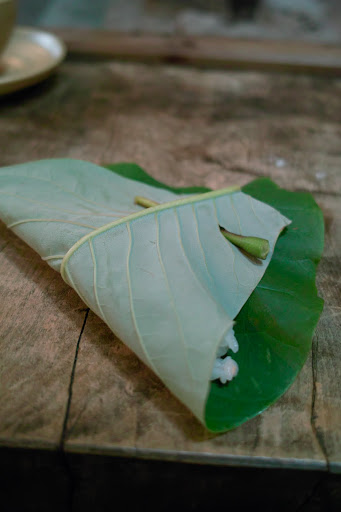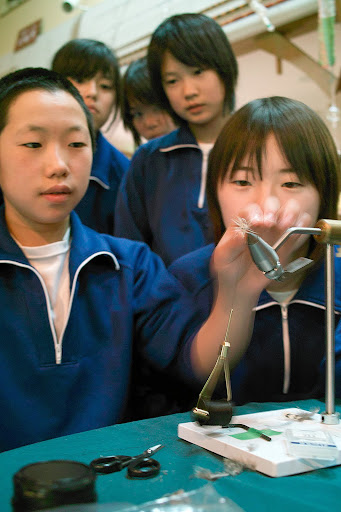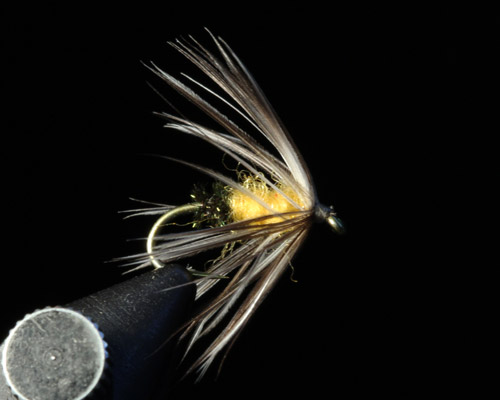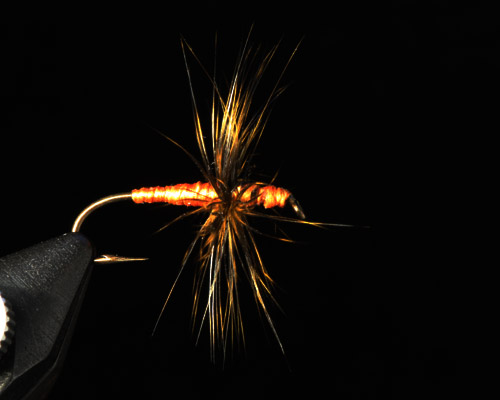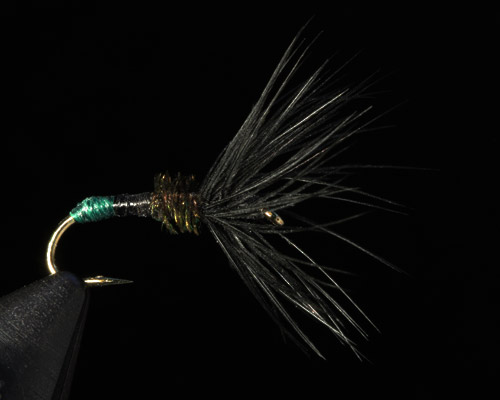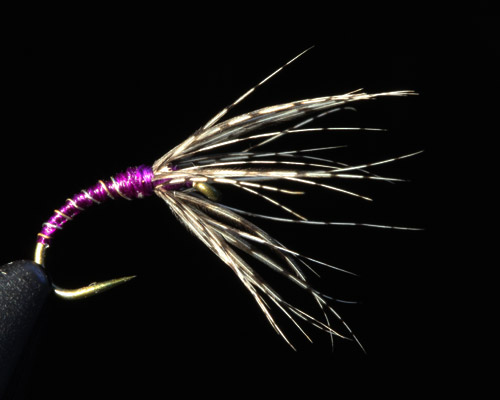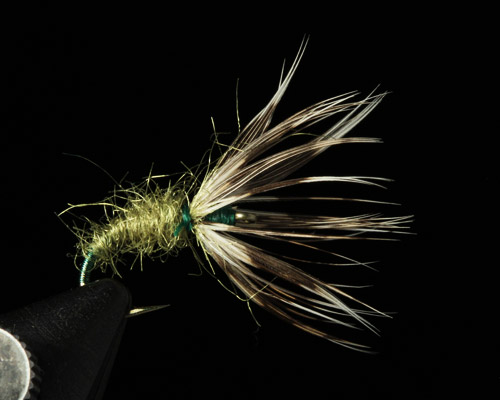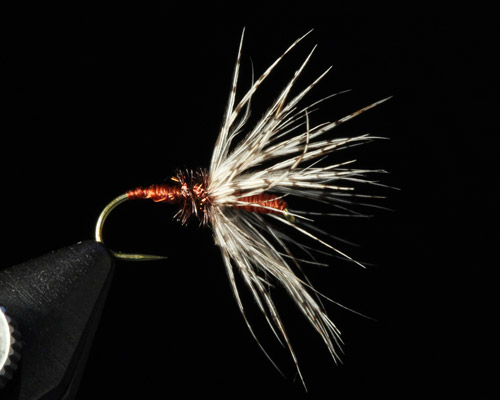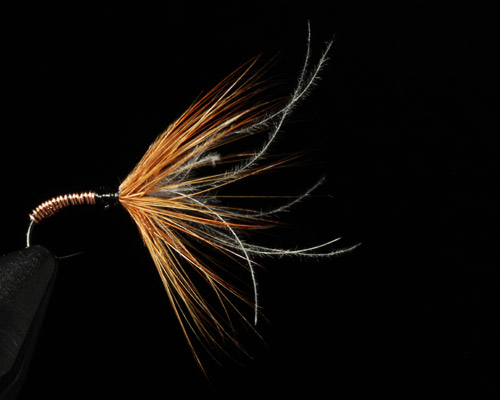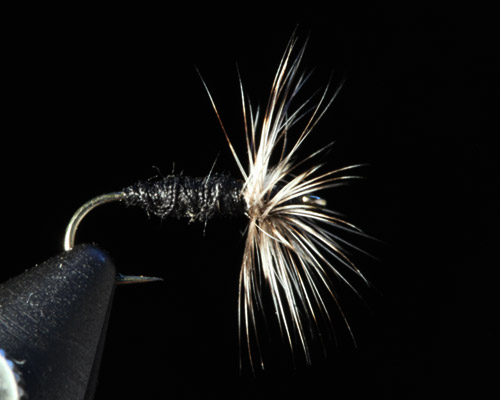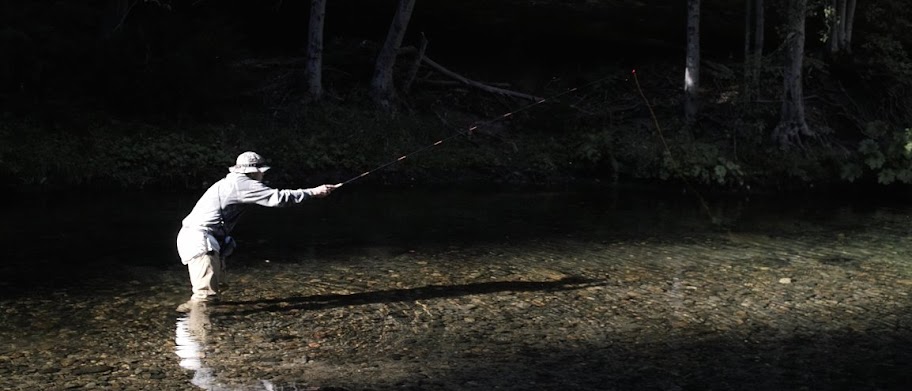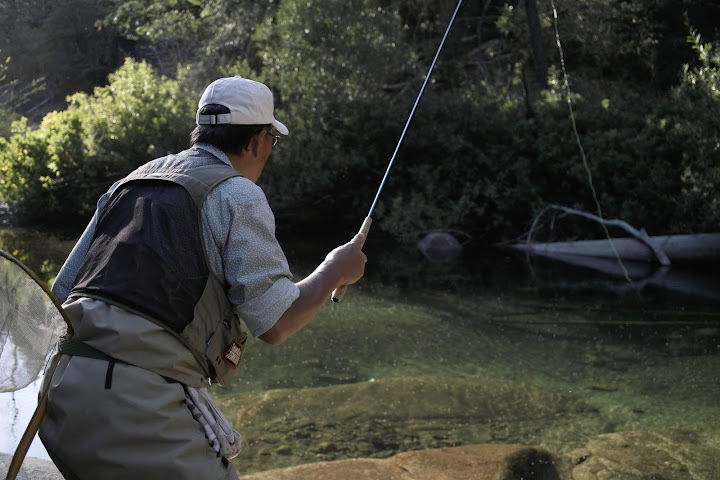A day with tenkara craftsmen
Yesterday I headed south to visit two craftsmen. The primary purpose of this trip was to visit the renowned tenkara net maker (tenkara tamo) Mr. Yukihiro Yoshimura, of the store “Mankyu”.
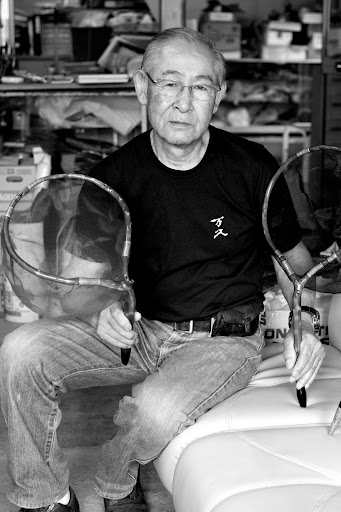
Visiting Mankyu was quite a dream. He’s the most renowned tenkara net maker in Japan and spending time looking at so many of his nets showed me he is a true master. Yoshimura-san has been making nets for 45 years, a craft he learned from his father. He’s also the longest practitioner of tenkara I know of , he’s been fishing tenkara for about 63 years.
Kuwata-san and I spent the morning with Yoshimura-san and his daughter, who helps him with the shop and works on connecting mesh bags to net frames. His daughter showed me how she connects the mesh bag to the nets by connecting a new bag to a frame I had made – they complimented my craftsmanship on the net construction, and gave me some invaluable pointers on finishing it. It was very impressive to see her skills at connecting the mesh to the frame, one of my most feared tasks. She said that often people make the frame and bring it to her for connecting the mesh.

We talked at length about tenkara nets. At one point in the conversation we discovered that both of us knew Katsutoshi Amano. Yoshimura-san picked up his cell phone and called Amano-san. Amano-san must have put in a good word for me, as Yoshimura-san then invited me to return and learn net making with him. I was definitely able to find time for that on my calendar, after all that’s one of the main reasons I wanted to come to Japan for an extended visit. I will be spending a full day with him the day before I return to the US.
Though I wish I had met him earlier to spend time learning about tenkara net making, this leaves me with an excellent reason to return next year, when I hope my Japanese will be much better. I will certainly write more about him after my day at his workshop. This encounter was quite a treat since Yoshimura-san frequently declines giving interviews to newspapers and magazines and has declined invitations by NHK to appear on tv.

I spent the night at the home of Kazuhiro Kuwata, who makes our tenkara leather wallets. It was great watching his craftsmanship as he finished a custom knife I had ordered for my own net making.
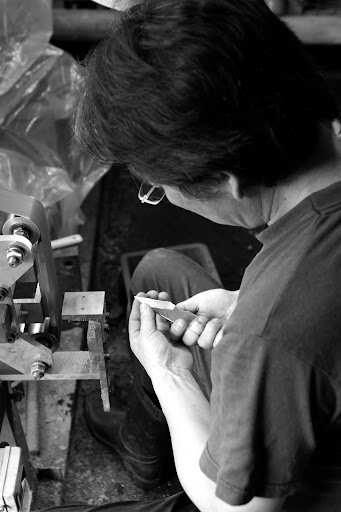
Kuwata-san lives and works in a large 100-year old traditional Japanese home in the country side. He loves vintage things and was attracted to the character of the house – which some people say is haunted.

We drank sake from his collection of Edo-period porcelain cups and enjoyed yakitori cooked on a irori . Kuwata-san doesn’t speak much English, so our conversations took place mostly in Japanese through the evening. Then he pulled out one of the vintage guitars he restored and played some American rock. These are experiences I wanted to have in Japan, and I’m happy I did.
Tenkara Class report
Back from a 2-day trip to Kaida-Kogen in Nagano prefecture. The event was incredibly fun, and I got to meet wonderful people.
In this picture Dr. Ishigaki teaching the class on day 2. Among other things he talked about the order one should try fishing a spot, start from the end of the pool and working your way up. He also demonstrated how working a spot from different directions can allow you to use different techniques (e.g. natural drift from below, pausing the fly from the side, dragging the fly from above, etc.)
Fishing was pretty difficult. I scored a few on Saturday, but got skunked yesterday. I had many drifts where I really expected a fish but nothing bit. I finally had a very nice rise at the end of the day, after Dr. Ishigaki and I had fished 3 other streams in the last couple of hours, and were at the end of our final 200 meter stretch with no bites of any kind. I got my fly to hang in one small spot long enough to get the interest of a fish, but I didn’t hook it.
The best thing about fishing frequently with someone who is a lot more experienced than you, is the confidence it gives you. Dr. Ishigaki likes to move quickly, so we’ll fish a stretch of a stream pretty fast and if nothing is happening we get on the car and check out a different section or different stream, as water temps or other factors may be different. But, there are days when it’s just not you, nor your technique, nor your flies, it’s just that the fish are not up to eating and there is not much that can be done about it.As has often been said, if it were much easier we wouldn’t call it “fishing”, we’d call it “catching”.
Preparing to fish a stream in the evening, the first of 3 Dr. Ishigaki would try in a couple of hours:
Moss-covered walls like these seem to be a constant presence on many streams. Walls have been built to prevent erosion of stream banks, since the water can get pretty high during heavy rains.
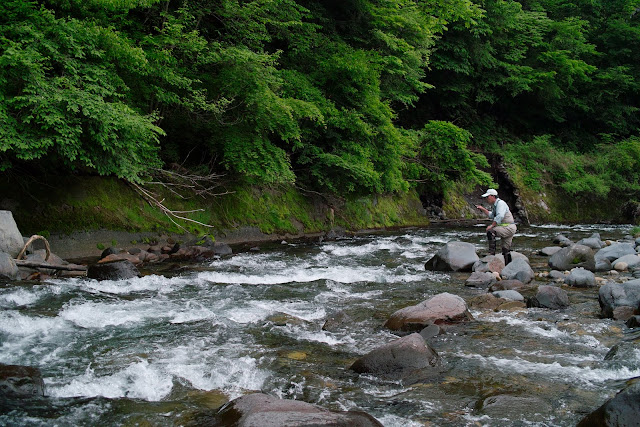
Our last stretch:
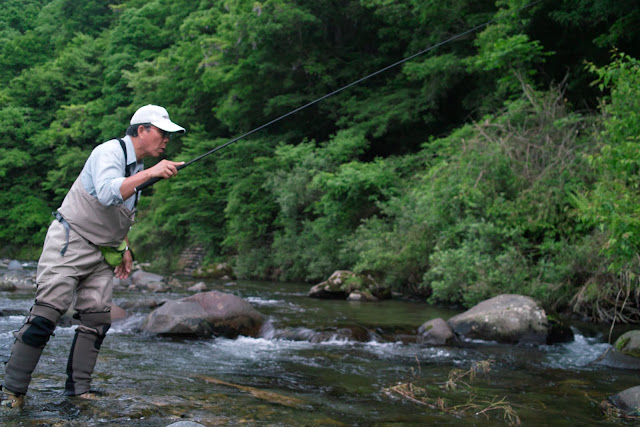
The inn we stayed in was pretty cool, a definite angler’s hangout. It’s called Mt. Ontake and run by Kazumitsu Suzuki and his wife. Here’s the URL for reference: http://www.mtontake.jp/. They served an awesome dinner and breakfast and at a very reasonable price.
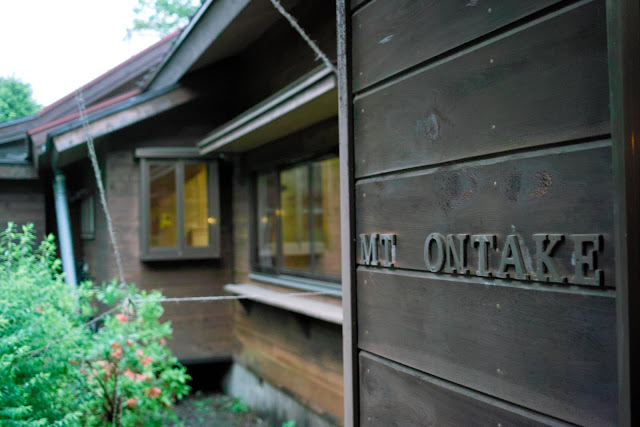
The spot is a regular destination for employees of the Patagonia store, which is how they got connected with Dr. Ishigaki. Last year he gave them a class on tenkara, and we’ll be there again this coming weekend to show them tenkara. It’s incredibly interesting how tenkara, Tenkara USA and the Patagonia company keep getting connected.
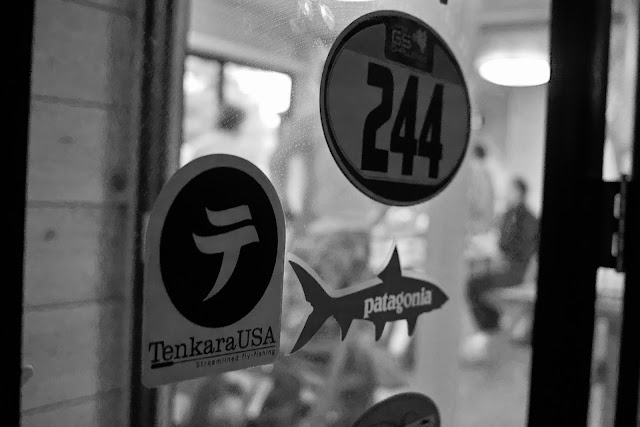
Suzuki-san and I got along great. He doesn’t speak English, but we were able to converse quite well about cameras, tenkara fishing, skiing and climbing Mt. Ontake, a trip we hope to do together next year. He even told me of a “secret” spot in Mt. Ontake area where he recently found several large Iwana but no one fishing as it’s a bit difficult to access. I may even be able to visit it before I leave.
Yesterday as the class took place, Suzuki-san took me around to fish in a couple of spots in the area. Suzuki-san is also a patrol for the streams in his area is responsible for checking anglers’ licenses. As he drove me around we stopped a couple of anglers. One didn’t have a license, but he readily pulled money to pay for it. Licenses typically cost about 1,000yen for a day ($12), and there is a penalty of 800yen if you’re caught without a license. Most people buy the license ahead of time, but it is a bit inconvenient to find the location to purchase one, so I don’t blame them for taking the chances without one.
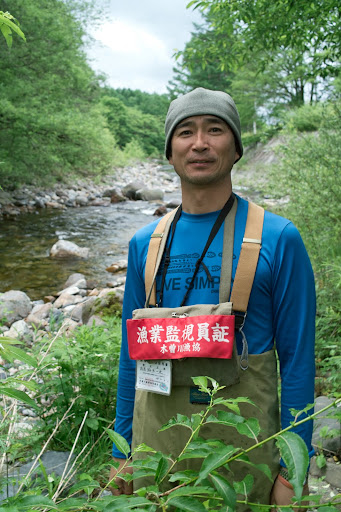
Tenkara in Japan – live
I thought I would not log on at all during the weekend, but found a few minutes of online time before heading to bed.
This morning I drove to Kaida-kogen, an area very popular among fishermen, for a tenkara class and fundraiser event with Dr. Ishigaki and Kurakami-san.
I left Maze at 6AM, arrived here at 8AM. It rained a little in the morning, and then hard in the afternoon. There were moments when the scenery was just awesome, at other moments the visibility was very low. Here’s a shot from one of the clear moments of the day when a layer of fog raises above the stream.
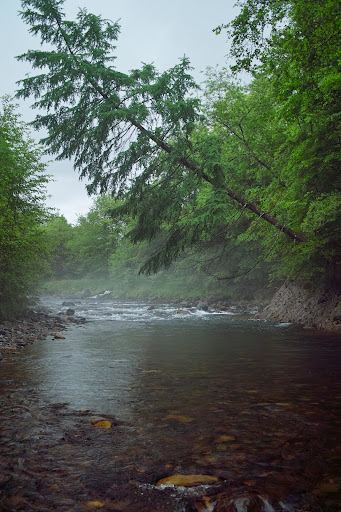
A little bragging, this morning I believe I was the only person to catch a fish in our group of about 15 people. And, in the afternoon I caught 4 fish, while the entire group had 1 fish among them. The stream has quite a few fish, but I believe the water was very cold today, and the fishing difficult. Not great numbers to really brag about, but it was easy to keep count today.

Here’s Ishigaki-sensei doing a demonstration to the class. He’s finally ditched the vest!!! Yes, he said it’s too hot and he doesn’t carry that many things in it anyways. I noticed he wasn’t using a vest on the Itoshiro event, so I finally asked him if he ditched it altogether.
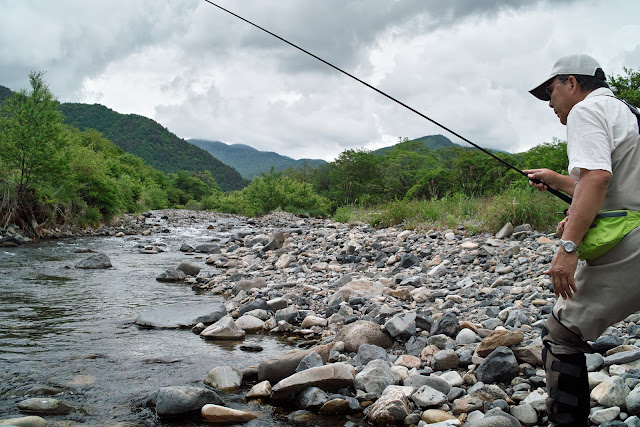
After fishing in heavy rain for about 4 hours, and catching my fair share for the day, I headed to an onsen. Just can’t seem to get enough of onsen, especially when it rains. I absolutely love that part of Japan for those rainy/cold days of fishing.
The most fun today may have been the charity event after dinner. Dr. Ishigaki and Kurakami san are taking every opportunity to raise some money for the earthquake victims. But, the event mostly consisted of underpricing things and if more than one person wanted the item they had to do rock/paper/scissors. It was a great way to have fun, but not a great way to raise money. I donated a Tenkara USA tshirt and a couple of sets of flies, those may have been the most popular items tonight. Then, the last item was the giveaway of a brand new Shimano tenkara rod. All those present participated in a rock/paper/scissors game to win the free rod. And, guess who won… yes, I did! But, I truly have no use for it as you may imagine, so I decided to turn it around and introduce an American-style auction into the party with bids starting at $50. The auction raised about $80, still a great bargain for the winner (photo below), but an additional chunk of money for the earthquake victims.

Pictures of tenkara fishing in Japan… and some Japanese terms for you
Tomorrow morning I’m headed for a 2-day tenkara event, and next week my schedule is packed. I hope to write more soon, but thought I’d leave you with a post of fishing before I go. This time I want to also share a few Japanese terms for specific types of stream, or terms that I use very often to figure out where to go fishing. Like the often cited example of eskimos have 30 words for different types of snow, the Japanese culture also developed a good vocabulary for describing their streams. To complete the post, I’ll include a couple of my best fish shots so far.
Japan has streams of many different kinds. The general term for river is “kawa“, but there are other more specific terms to describe different streams. Kawa can be “honryu“, which is the main stream, or “shiryu“, which are tributaries. Of course, a shiryu can also have other shiryus… Two other terms I use very often are “karyu“, which means downstream, or “jiuryu“, which means upstream.
Some are small, boulder strewn mossy streams. These are normally called “sawa“, the term for small streams, such as the one Yoshikazu Fujioka-san is fishing below, and my host Ikumi is fishing below that. I’ve been teaching Ikumi tenkara fishing and am very proud of how good her form is. We’ve only been out 3 times and her casting precision and technique impress me. She caught a fish on this evening (yumazume = evening activity period), Rocky and I didn’t.
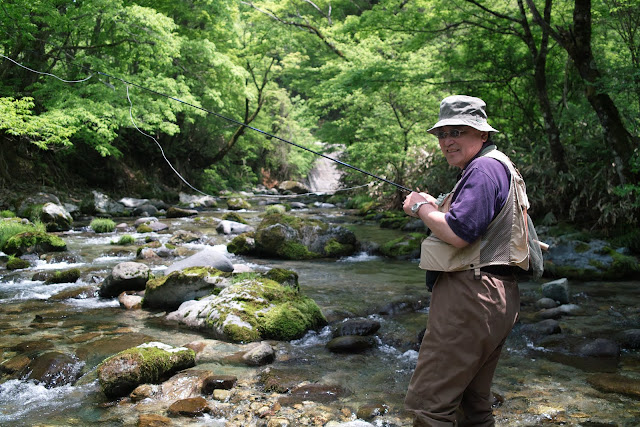

Mountain streams in general are called “keiryu”.
The keiryu below is being worked by Chris Stewart, the “Tenkara Bum”, who is referred by our Japanese friends as “tenkara baka”, though we’re still unsure that’s the best term for a bum. This was the “shiryu” to the Itoshiro, which is the “honryu” in the area we fished and one of the few catch and release streams in the country.

Keiryu also come in different styles. The clearest ones are called “seiryu”, which indicates they are “clear/beautiful/moving water types of streams. They may be large or small, but have the characteristic features of a mountain stream, boulders/pockets/currents. The Mazegawa is referred to as a seiryu. The Mazegawa has at least 100 distinct parts, that feel like entirely different streams. The one picture below shows my hosts, Ikumi on the foreground and Rocky farther downstream. The pool in front of her is about 12ft deep and we could easily see every rock below.
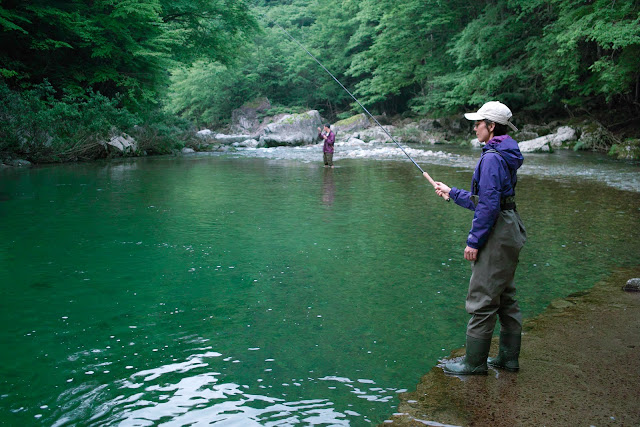
Some are large, slower rivers, these are just normally referred to with the general name “kawa/gawa” – there may be a more specific term, but I still haven’t learned it. The picture below was taken in Gujo soon after the ayu fishing season started. I’ll write more on ayu fishing later, but for now, suffice it to say it’s not tenkara! It’s done using a live “decoy fish”. It’s definitely a serious activity here. I may even call it “the bass fishing of mountain streams”.
Other streams are very steep, and the walls around it form a type of canyon. These are generally called “tani/dani”. These are the streams where people may do “shower climbing”, or sawanobori – interestingly, the activity is called “sawanobori”, because tani may or may not have water in it (it’s a canyon area), and shower climbing requires water, thus “sawanobori” is used. I helped take a group of kids on an outing to one of these streams, but no fishing allowed there. Next friday I’m scheduled to go explore a “tani” and will do some tenkara fishing. Actually, I’m supposed to catch lunch. Here’s the place I wish I had fished, but instead I enjoyed some awesome canyoning:
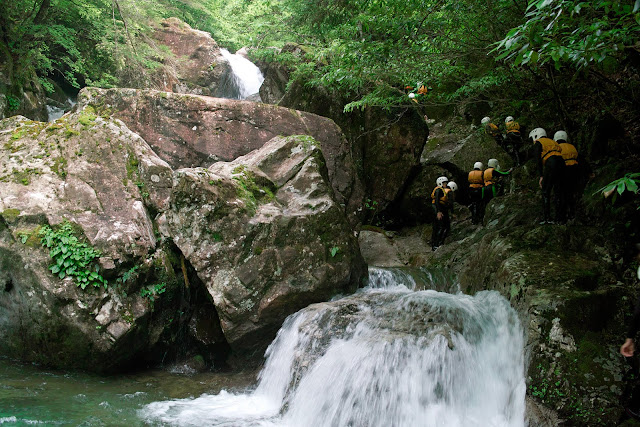
The fish here are just gorgeous, when I can see them I get excited about fishing again. In this area we can catch Iwana, and Amago. On the Japan sea side, one may find the yamame. Next week I have an outing scheduled with a local whose favorite stream is a couple of hours away and we can catch yamame.
This is a picture of a Iwana, my best fish on this trip. It’s not the largest fish one can catch here; last week on the ryokan I visited, the owner had a beautiful mounted display of a 20.5inches (52cm) Iwana. The Fishing Center has a dried 25inch Iwana on their wall. Tenkara was also used to catch some large fish.

Here is an amago I caught on a “shiryu”, the term for tributary. Notice the small red spots, the differentiating mark between the amago and the yamame. I hope to have a picture of yamame next week.

Visiting the tamo shops
Early this week I looked at my calendar and Wednesday was a free day – I have been busier on this trip than I had ever imagined. So, I decided to revisit the tamo shops a couple of hours away from here. This was my third visit. I actually had to return before I leave to pick up a couple of pre-ordered mesh bags for my nets. But, mostly I was excited to look at all the nets I could before the end of my trip.
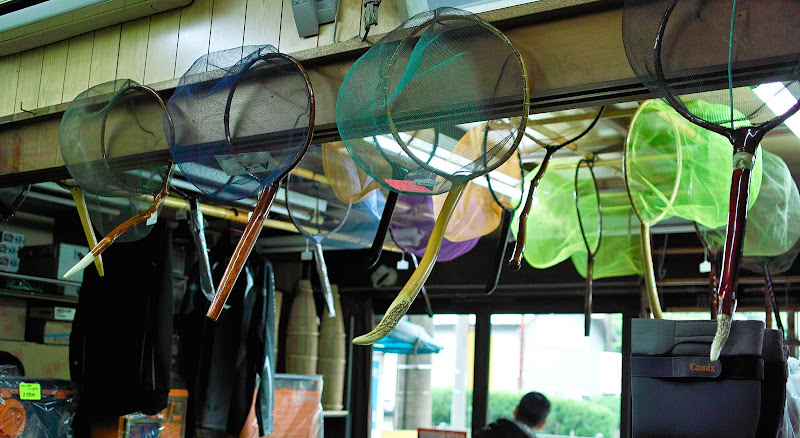
On the drive over, I noticed the same mountains I had seen when driving with Chris a couple of weeks ago. This time I found a better viewing spot and was able to setup my tripod for a more stable shot and some video.
Last year Dr. Ishigaki took me to visit one of the stores, where I fell in love with tenkara nets. Then, a few weeks ago Eiji Yamakawa and his friends came to this area, but as it was raining very heavily on our second day they decided to visit the tackle shops instead of going fishing, I tackled along. This time I wanted to go on my own. I wanted to take my time in observing the style of different net makers and I wanted to talk to the owners of the stores with no rush, no time to go back, and without feeling like I’m taking someone else’s time. Furthermore, this would be excellent Japanese practice.
My Japanese is still very crude, but I’m finding that on the topic of fishing I have been holding decent conversations, being able to ask the questions I want (even if sounding like a Tarzan), and understanding most of the responses. Sometimes I still count on my iPhone, which in Japan has become an expensive dictionary, though I’m relying on that less and less. Also, I do keep a small moleskin notebook and pen with me at all times and take note of new words and refer to ones I learned before. I have had numerous hour+ long conversations here, and those have been some of the most fun (though challenging) experiences in Japan. There is something about living on the country-side, where people seem open to taking their time in conversing with a stranger, arriving at common grounds and sharing common experiences. Whereas most encounters in big cities seem dictated by a one-hour time block, here I have sat for a cup of coffee and talked with people with no pre-allocated amount of time. Sometimes conversations are quick, other times 3 hours long, nonetheless each is a big opportunity to learn about 10,000 new things.
(by the way, though tenkara is mostly for smaller fish, if you still think it is only for the very small fish, take a look at the mounted fish on Shimizu’s wall, fish of that size or larger are a common decoration on walls of businesses in this area)
The first tamo shop I stopped at is owned by Shimizu-san. By far my favorite store and where I got my first net last year. A few weeks ago when we tried to stop by they were closed, so I was happy to find his store opened on this visit. Shimizu-san’s store has been around for about 40 years and was previously owned by his father. At this time of year, ayu fishing season is starting and the river across the street from his store was filled with ayu anglers (more on this later). A couple of times fishermen came in dressed in their neoprene waders to talk to Shimizu, as I admired each of the nets he had on display. This year’s collection of nets from different makers was nothing short of extraordinary. The nets were much more expensive than they had been last year, but each of the nets was of very high quality. Also, his store only stocked kaya-tree nets this year, as opposed to nets made from other trees like the “momi”. He says kaya nets are the best and he’s not carrying nets from other woods this year. He and I had a good conversation. I didn’t meet him last year, but he said his wife had mentioned meeting me last year.
Then, I revisited another store where I had stopped a few weeks earlier. I actually had to return to the area before I left since I had pre-ordered 2 custom mesh bags from the maker. I had asked if they had any mesh bags to sell, but they didn’t, preferring instead to use the bags for their own nets. However, he agreed to prepare a couple for me and have them ready within about 10 days. So, I stopped there and picked them up for my upcoming kaya nets. Here’s a picture of the maker about 30 years ago, this picture hung on the wall:
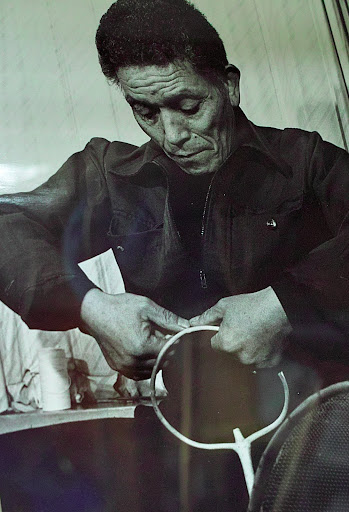
Remembering earthquake and tsunami victims 10,000 candles
This weekend the Mazegawa Fishing Center hosted the Hoba Sushi Festival. The highlight of the event was the lighting of 10,000 candles, made from recycled cooking oil, to remember those who lost their lives on the earthquake and tsunami disaster of March 11th. The candles lasted as long as 3 hours as those present enjoyed live performances by a group of artists. Everytime I looked around I was filled with awe from the energy around us. The moon popped behind the mountains on the other side of the river, candles lined up the small stream feeding the Mazegawa. It’s hard to put into words the energy I felt at the event, but thought I’d share a few pictures.
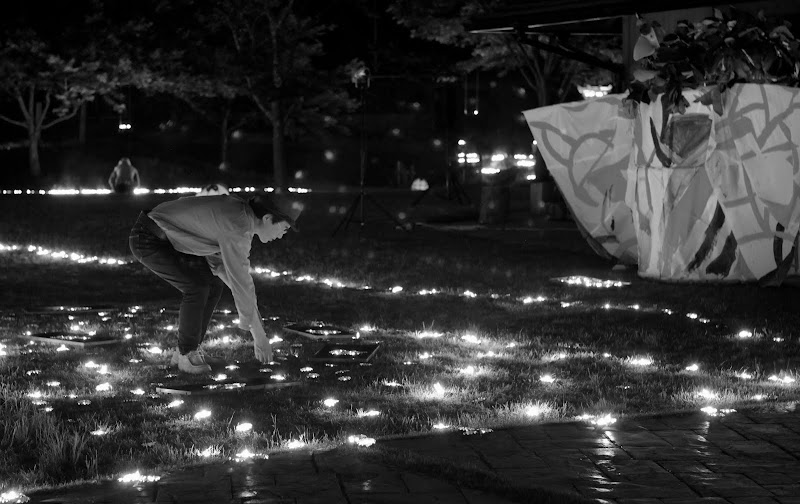


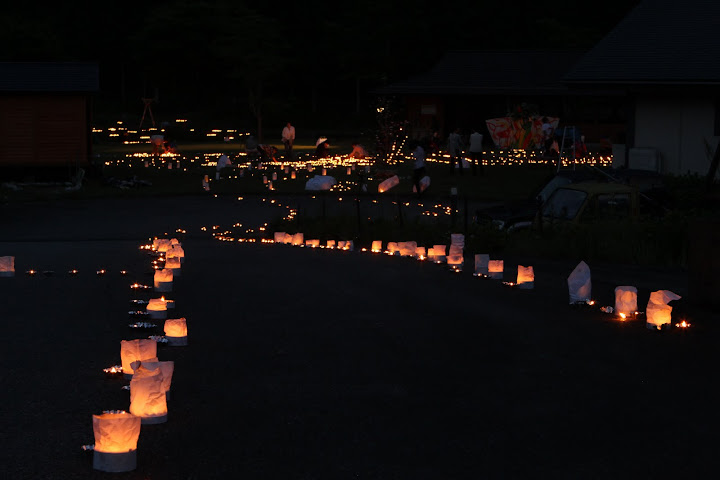




Today's view from my room
Actually, the title is a bit delayed. This was the view from my room yesterday, when I stayed at a most quaint ryokan (type of hotel) in the small town of Osaka 小坂 (not to be confused with the big city of Ōsaka, 大阪). In case anyone is interested in coming to this area (highly recommended if you can), the ryokan is the Sengakukan, very famous in the region (and for disclosure, I did receive free room and board without any expectations of promoting it, though I’m happy to do so).
Osaka is famous for its waterfalls and “shower climbing” (canyoning through waterfalls and pools). In all, the area is estimated to have over 216 waterfalls, though some people suspect it has even more falls that are hidden deep in the woods.
How I cam here was interesting. On Saturday, I met the owner of the ryokan here in Maze. She said her husband really likes fishing, and that I should get to know their town and possibly fish with him. She invited me to come the next day and stay there. What an awesome couple of days those were.
The ryokan was right next to a gorgeous river, which you can see on the picture above. The owners of the ryokan took me around town to see the waterfalls (they hiked around in their yukata robes, adding to the feel of “romantic Japan” that many people may have).
After hiking to the falls I met two local guides of my age, who volunteer as guides during the weekend. They said they do shower climbing and enjoy fishing. We agreed to fish the yumazume (the evening activity period) together. We were also treated to a 5-star dinner by the owners of the ryokan and were joined by their son who works there and is about my age. Unfortunately, we couldn’t find dates to go shower climbing/tenkara fishing together before I leave. I have to return next year so we can do the 3-day canyoning trek to Mt. Ontake.

The fishing was okay. As with most streams in Japan, the number of fish in the rivers was not that large. The fish that do remain in the water are just gorgeous, as they have not been beaten up by bad catch and release practices.
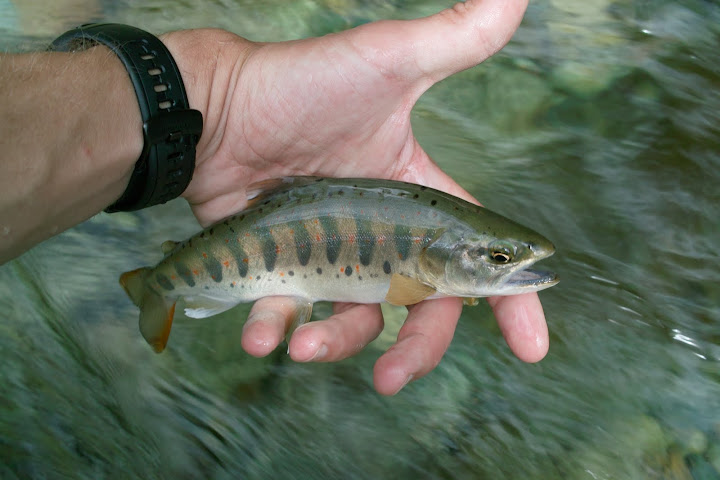
The stream behind the ryokan featured a few points where natural spring water bubbled up. The onsen water feeds a fountain inside the hotel where one may drink it – it has a very interesting soda texture to it, but tastes a bit like, well, fart (yes, the sulphuric smell of many onsen water sources). Apparently it’s very good for your health, but I could only must a glass of it. A few dishes are also cooked with that water. Hot onsen water also feeds the outdoor bath of the ryokan. Today I learned that the word onsen is used for both hot and cold spring water, though it’s normally associated with hot water in Japan.
I will have to write another post very shortly about the Hoba Sushi Festival over the weekend. It was a surreal event during the evening, as we lit 10,000 candles on the fishing center grounds and lining the banks of the stream next to it to remember the victims of the earthquake and tsunami.
Japan as a mountain painting
There are paintings that portray the mountains of Japan forming beautiful layers of colors. I have been seeing these pretty often when I drive to different fishing destinations. This was a shot taken when Chris and I were driving to Itoshiro. It was awesome to see 6 clear layers of mountains overlapping each other.
Tenkara in Misty Mountains
It is true, misty mountains, with a thin layer of fog just in the right place, may be a stereotypical image of Japan. Nonetheless, they are real. Images of these serene and somewhat mystical mountains probably come to the mind of many people when I say I’m spending time in a remote mountain area of Japan. They are a constant presence here, and sometimes very dramatic. Yesterday, after the rain stopped, there was a magic feel to the mountains above the Mazegawa; fog surrounded them, raised above the stream and made me feel as if I were in a movie set. I stopped the car and tried getting some good pictures. The fact that in my car I had a cd playing traditional flute music definitely helped set the mood.
Yesterday's stream that I didn't fish
Following a weekend of typhoon weather, with very heavy rains that raised water levels by about 3ft, yesterday I didn’t fish. But, I couldn’t sit still. I wanted to see what kind of photography I could capture with water levels still a bit high in most places (though not nearly as high as it was on Monday). The light was pretty interesting. I spent a few hours hiking along sections of the Maze river and found this spot. The climb down to the river was very difficult, and perhaps a bit dangerous, but the setting idyllic. The moss remained on the rocks despite a roaring river the day before. It was meditative, not a person nearby. I plan to fish this stretch when water levels return to normal.
Photo updates from Japan
I know, I know – I promised to write a bunch while on my “sabbatical” in Japan, and I haven’t been delivering. I have been fishing though. I have fished with a bunch of great people and some of the masters of the art of tenkara. I have been enjoying some of the most beautiful streams I have seen and seeking others. I have also found some wood for my new tenkara nets. So much going on, so little time. It’s already been almost 20 days since I arrived in Japan. And, yes, I have been learning more about tenkara. I will share more. Meanwhile, here are some pictures from the last couple of days:
A gorgeous stream, a “shiryu”, or “tributary” of the Mazegawa:
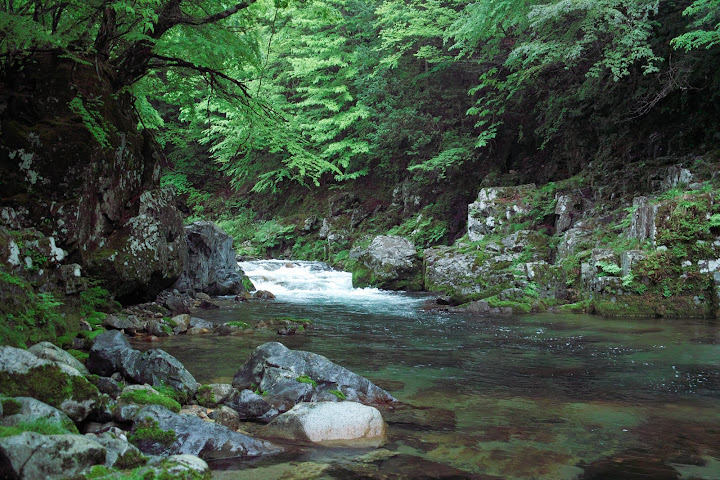
While many people take a lot of fish, I’m happy to know fish can find sanctuaries of gorgeous water, but no fishing allowed, this is what the sign looks like:
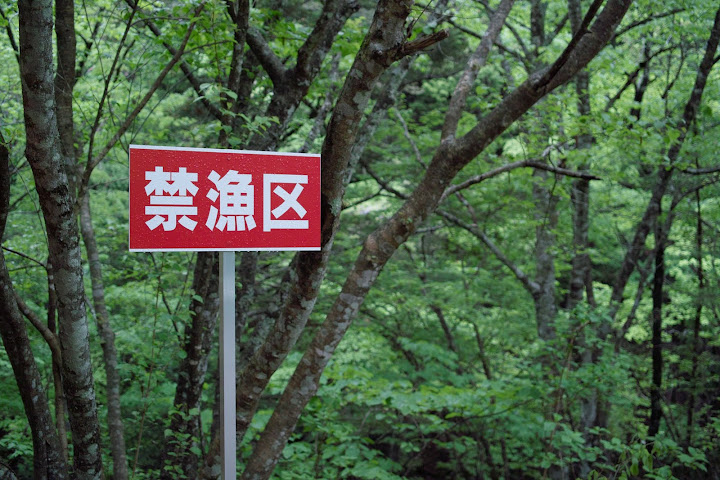
Fishing with Eiji Yamakawa, and two of his friends from their tenkara fishing club, awesome guys:

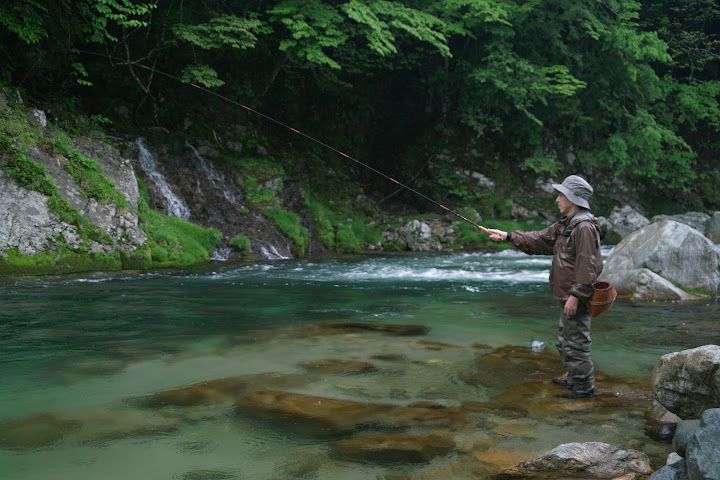
After much looking, finally found the rare “kaya” tree [update: they were not kaya, but rather the more commonly found “momi” trees, I finally found an ancient kaya forest and learned about their differences]. I found the trees 2 days after reading that as much as 45% of the forests of Japan have been replaced with cedar (“sugi”) tree plantations. Indeed, cedar is about all you can find here, but deep in the woods there are other trees. I climbed a kaya momi, and found others where the branches were accessible. What an impressive tree:

Fuji no Hana 藤花Originally posted on June 10, 2010

There will be some new content for those of you who have been reading our blog for over a year. I do not want to keep duplicating entries, but, this one is a timely one for our area of Japan.
Last year I talked about how the Fuji flower (藤花, fuji flower, wisteria japonica), is considered to be the “tenkara flower”. This is because when the fuji flower’s blossom is an indication that fishing is good. I have been in Japan for over 15 days now. Sadly, the fishing in this area has been very poor, and, tellingly, until yesterday I had not noticed the Fuji flowers in the area I’m staying. Today, they seem to have bloomed and are starting to appear in many places. While I still suspect the fishing here won’t improve all that much (I’ll talk some other time about the poor management of fisheries in Japan), the almost overnight flower’s blossom is a sign for hope.
Originally posted on June 10, 2010, after fishing in Japan at this exact time of year last year.
This time of year is considered the best time for tenkara fishing in the mountain streams of Japan. One of the main indicators of this is the Fuji hana (藤花, fuji flower, wisteria japonica). The fuji flower is commonly found near streams in Japan at this time of year, and when it’s blooming it’s said to be tenkara fishing time. So, I’ll call the fuji flower, the tenkara flower. Now we need to find one for tenkara in the US.
The character for the fuji flower (藤) is the same character as Fujioka-san (藤岡), so they joke that’s his flower. This is the fish he caught just about an hour earlier:
Fujioka-san with a nice Iwana
One morning I was able to get very close to the fuji flowers, they tend to be found a bit high, but a few hours before I was able to I had dunked my camera’s lens, a big SLR lens, into the water as I landed a fish. It’s what I call my karma neutralizer. I didn’t realize it until later, but the picture I took was a bit foggy. Luckily I was able to get back there before the trip was over and take a better picture.

Zenmai kebari Originally posted June 16, 2010
As I spend time in Japan, I realize how much I have already covered in our blog in regards to tenkara. This blog has a wealth of information regarding tenkara, unmatched anywhere. Yesterday a local reporter came to speak to me about tenkara as he’s helping put together some type of museum of fishing . I started bringing up all these things that he wasn’t aware of, and pulled my computer to show him what I was talking about. Among these posts was one about the use of the Zenmai Fern dubbing material on some old flies.
It seems like I’m too late to collect zenmai fern in this area (they came up in early March this year), but I thought some of you may have not read this post before and may be interested in reading it.
Originally posted on June 16, 2010 after my last year’s visit to Japan.
ZENMAI
I love the idea of using natural materials on all my flies. Through tenkara I learned about a material most people accustomed to the western fly-tying traditions have never heard of and very few have used, even though its properties make it a great material and it’s available in most parts of the world, including the US: the zenmai.
The zenmai was first introduced to me by Fujioka sensei, my teacher of tenkara flies, through his excellent website. A few months ago he sent me some flies, and also a small bit of zenmai, which I would not dare use as they belong to the “museum”. While fishing with Fujioka sensei, I asked if he had seen any zenmai around, “it’s a bit too late in the season”, he replied. Usually the zenmai comes out in very early spring and the fleece falls off soon after. However, as luck would have it, Fujioka sensei later went to an onsen (hot springs) at a higher elevation and there he was able to find some.
Fly tied by Fujioka sensei using the zenmai dubbing material.
The zenmai is a type of fern that, in early spring, has a cotton-like material on its body. This cotton-like material makes for excellent dubbing material, it is relatively waterproof, and can be easily made into a tight thread. Depending on the time it is picked or the plant it is picked from, the zenmai will vary slightly in color, with some being darker, and more commonly found in a light tan color.
Usually referred to as “flowering fern”, the zenmai belongs to the Osmunda family. The Japanese species is the Osmunda japonica, but according to Fujioka sensei the zenmai may be found worldwide, except for Australasia. The plant can be found in two stages with fleece still on its body: more commonly it’s found as a fiddlehead fern, a young shoot coming out of the ground and still curled up with fleece covering it almost entirely. Or, as a grown plant with the fleece material still on its stems, like in this video.
Though a bit hard to find at this time of year, there were still a few plants around during my visit (late May-early June). The day after Fujioka sensei gave me some zenmai, I found one plant with the fleece still attached to its body. The following week, as I visited my wife’s grandparents farther north in Yamagata, they found some more zenmai stalks while picking sansai (mountain vegetables). That’s another cool thing about this plant, the Japanese zenmai is an edible plant, a sansai, which is commonly picked by people in the mountains areas of Japan. The cotton-like material is discarded, and the meaty vegetable prepared and eaten. On this day, vegetable picking proved to be more productive than fishing (the water was too cold, I believe). Among a couple of enormous bags we picked of warabi, and fuki were a few young fiddlehead ferns still fully covered in zenmai fleece.
After being dried for a while, the zenmai can be prepared as a delicious mountain vegetable. We had some awesome meals with these on the side.
Hands full of sansai. In this case, warabi.
I know some tenkara anglers in the US have already picked North American zenmai this year, for their own flies. But, I’m afraid this post may be too late for most people to be able to find it now.
Tenkara Japan A quick preview
Sakasa Kebari tied by Amano-sensei, free-hand, with no tools and eye-less hooks. Sakasa Kebari hold quite a esteem here.
It’s been 12 days since I arrived in Japan seeking to learn more about tenkara and experience the mountain fishing culture of Japan. This is my third visit to Japan, and each time I continue to learn more and more about tenkara. Who knew such a simple method of catching food would have so many subtleties to keep me coming back!
Tenkara and Tenkara USA for me are much more than selling fishing rods and other items; I’m very passionate about sharing the method of fishing with you. I’m happy to be writing this and working on videos, pictures and other content from my new room overlooking the mountains of Gifu. I will try to find time between fishing and hanging out with the people from the area to share what I learn on the blog. Rainy days like today are perfect for that.
After about a week of travelling, I have now been settled in what will be my home for the next month and half in the small mountain stream village of Maze, on the Maze River in Gifu, Japan. It’s a beautiful, idyllic setting. Very inspiring. Out of 12 days in Japan I think I have fished on 8 of them. I can’t say enough about how beautiful the streams here are, I absolutely love them. Crystal clear water, emerald gems with movie-like settings of cedar forests and mossy rocks.
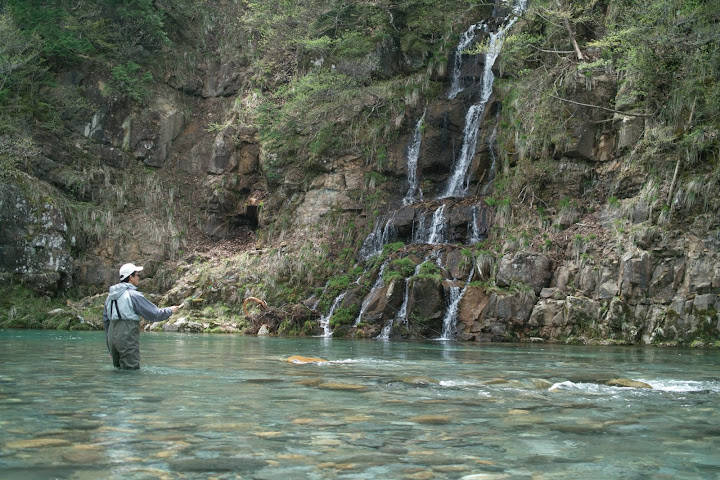
Chikara fishing an idyllic stream, great fishing, poor catching 😦
But,unfortunately, I’m quickly acquiring a new appreciation for the streams in the US and sometimes I wish I could mix the best of both worlds, where regulations, and stream management and keep-limits would make the rivers here more productive. Rivers don’t have a keep-limit and the concept of catch-and-release is virtually unknown – though I revisited the Itoshiro River, a very productive C&R river about 1 1/2 hours from here. Out of the many stretches of streams I have fished in this area, few showed much sign of life. I did catch fish just about every day, but it was hard work! Conditions are good, insect life very abundant, but the fish seem to be mostly gone. A shame, but we’ll see what I find deeper in the forests.
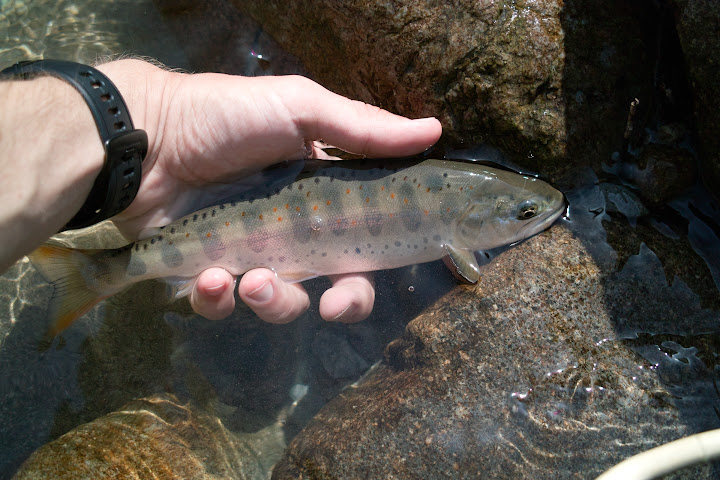
A beautiful example of an Amago, a native, though seemingly rare fish.
My host, Rocky Osaki, manager of the Mazegawa Fishing Center, and his wife Ikumi, have taken great care to introduce me to the community of both anglers and non-anglers in the region. I have been blessed to be invited into numerous homes where I soak all I can about tenkara, fishing culture and other aspects of life here. And, of course, have been soaking on the local onsen every chance I get.
A local kid whom I just had to nickname “Sanpei”, he doesn’t seem to mind.
This weekend there was a wonderful event here. 3 tenkara masters, and I do not use that word lightly, taught a course on tenkara to a group of about 15 people. I spent most of my time with Amano-sensei (more on him later, but quite a character and a most skilled tenkara angler).From each of them, as well as other very experienced tenkara anglers, I have learned more about tenkara.
Tenkara fishing course
Ah, and today I was featured in the regional newspaper, in an article talking about the event and the presence of Tenkara USA there:
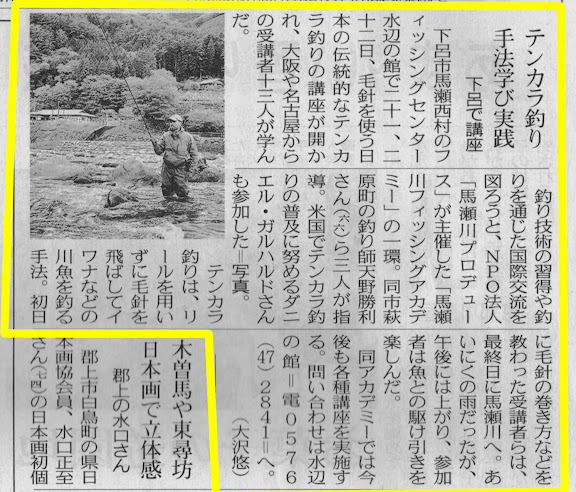
Checking in from Japan A view of where I'm staying
Not much writing on this blog post today.
But, in case anyone is curious, here’s a panorama I did yesterday with my iPhone of the Mazegawa Fishing Center. This is the place I’m spending almost my entire time. It’s one of the coolest places on earth to spend 2 months. A fishing center, with access to canyoneering gear, a tenkara-perfect river right in front of it and a hot-spring onsen just up the hill. I’ll try writing more later. Now, back to studying Japanese before I head out to fish some more.
Hope most of you can see this 360′ view of the place. You may need special software for it and I apologize for that.
Here’s the location of where I’m staying, notice the abundance of mountains and streams in the area!!! The town I’m staying doesn’t have a convenience store, nor traffic lights. It’s very quite, and gorgeous. Mountain view galore, and streams in abundance:
Montana, a tenkara-perfect state! Backpacking, packrafting and tenkara fishing
As I have been preparing for a 2-month long trip to Japan to learn more about tenkara, I have put off writing about a phenomenal backpacking tenkara trip in Montana with Ryan Jordan from BackpackingLight. Ryan was quicker to put his insights “on paper”, and wrote a great post on how tenkara is not only the domain of small streams and small fish. Here is a bit of my account before I board my plane to Japan (by the way, keep checking in, I’ll be writing and posting a lot of pictures and videos while I visit the birth-place of tenkara). If this post seems a bit disorganized – it is. Please forgive me; besides packing, I still have to finish Canadian sales taxes, CA sales taxes, copy for a new catalogue, final procedures and all the fun stuff that a business owner who’s decided to spend a couple of months away learning more about his passion has to take care of.

One of the highlights of the trip, Daniel with a 19" brown caught with tenkara on the Madison, photo by Ryan Jordan
Interview with Misako Ishimura
Misako Ishimura is the co-author of the book Tenkara – Radically Simple, Ultralight Fly-fishing , and she agreed to give us an interview, sheding a bit of light on her background and connection with tenkara.
Misako, you have greatly contributed to helping introduce tenkara to the United States. I think it was some type of sign that you were working on the “Made in Japan” exhibit for the Catskills Fly Fishing Center and Museum right at the time I was working on launching Tenkara USA. Almost exactly one month after Tenkara USA launched, the highlight of your exhibit was a demonstration on tenkara by Dr. Ishigaki who came from Japan for the event. Now, 2 years after tenkara was first introduced to the US, you worked with Dr. Kevin Kelleher on a book which will open the doors to fly fishing for many people.
TUSA: Can you tell us how you first discovered tenkara and how long you have been practicing it?
Misako: I started to research Japanese fly fishing history in year of 2000 because many anglers from the other countries at FIPS Mouche World Fly Fishing Championships have been asking me about Japanese fly fishing. During my research in Japan, I discovered tenkara. It gets my interest since tenkara is the way to catch beautiful Japanese trout. Every time I’ve been to Japan, I collected information about tenkara little by little. Finally I had a chance to learn actual tenkara fishing from Dr. Ishigaki in the mountain stream in Gifu prefecture in June, 2008. Since then, about four years, I have been practicing it.
Utah, indeed a tenkara-perfect state
Recently two of our customers, Erik and John, started organizing a tenkara gathering in Salt Lake City, Utah. I had been looking forward to returning to the area. The last time I had been there I spent a week fishing every day after work. The mountain stream fly-fishing in the area is phenomenal. That was pre-tenkara, and I had been looking forward to tenkara fishing in those mountain streams. I knew they would be tenkara-perfect. Indeed they were.
Below is a slideshow of the 4 days I spent in the area. Every day as perfect as it could be. On Thursday I arrived at the airport in late afternoon, checked into my hotel, and headed to one of my favorite streams. I called Erik up, and he was already there – mind you we had no plans to meet that afternoon, but we had a blast fishing together. Friday was a nice repeat, and it included John. Awesome company in small stream fishing. On Friday night I gave a talk at Western Rivers Fly Shop in SLC. They don’t currently carry our gear, but were very welcoming and eager to learn more about tenkara and have their customers also learn about it. The talk was followed by a great dinner at a sushi restaurant not far from the shop. Saturday we resumed the “talk” with on-stream demonstrations. We fished all day, caught some nice fish. More fishing Sunday on one of the most gin-clear streams I know. On Monday I headed up to Logan to meet with our dealers in the area. Round Rocks brought in a great crowd, many already avid tenkara anglers. The rivers were completely out of control and it was raining but I still gave the on-stream demonstration, on the stream that runs right behind their store. It was very cool to teach real tenkara to people that were so used to using it similarly to western fly-fishing.
Today I came to Bozeman and already have some great stories, which I hope to share soon, including tenkara fishing in the middle of an unexpected snow blizzard today. Tomorrow morning I’m heading on a 2-day backpacking trip with Ryan Jordan, founder of Backpackinglight.com. Definitely looking forward to this and to sharing it all with you. All in all a great time. Enjoy the pictures.
https://picasaweb.google.com/s/c/bin/slideshow.swf
Iwana 12ft, series I, back in stock Limited quantity
After the incredible surge in demand over the last month we quickly sold out of one of our most popular rods, the Iwana 12ft. To meet the on-going demand we brought back some of our series I Iwana from the Canadian warehouse. These were just added to our inventory and will be available until sold out, probably within the next 2 weeks.
If you had been waiting for the 12ft Iwana, now’s the time to get it. This is the first iteration of the Iwana rod, which has a shorter handle (9 inches instead of the current model 12″ handle). It’s a very nice rod, and what created the following for the Iwana. The Series II, which has a longer handle, and better quality cork, is expected back in our inventory approximately the first week of May.

Tenkara in the media Ralph and Lisa Cutter and John Gierach embrace tenkara
We are absolutely ecstatic this month! Tenkara has reached the mainstream through the words of 3 of the most respected anglers and writers in the US: Lisa and Ralph Cutter and John Gierach. These articles were published in what I have come to perceive as two of the most progressive magazines in the industry: California Fly Fisher, and Fly Rod and Reel. these magazines have been ready to tell their readers about tenkara, a new development in the US, which I think proves their editorial integrity and that they are concerned with telling their readers what is new in fly-fishing as opposed to just pushing their advertisers’ wares. Kudos to these two magazines.
Ralph and Lisa Cutter write about tenkara for California Fly Fisher
Ralph & Lisa Cutter wrote a great article on their first experiences with tenkara for California Fly Fisher, with a beautiful illustration of a mayfly landing on a bamboo stalk done by Lisa. Getting to meet Ralph and Lisa was quite awesome in itself. I had known about the Cutters’ work for a long time, and always suspected they would probably enjoy learning about tenkara. One day, suddenly and unexpectedly, I received an email from them. Ralph says that Yvon Chouinard was visiting with them for a couple of days, and Yvon kept talking about tenkara. With so much “tenkara this, tenkara that”, Ralph couldn’t resist and got in touch. It just so happened I was in the Sierras and would be going past their place on my way back home and also had some rods in the trunk of my car. I personally delivered the equipment, and gave them a brief lesson. As they attest in their article, there is more to tenkara than is first expected, ” the few videos and descriptions of tenkara I had seen prepared me for a lesson in dapping and high sticking.However, when Daniel made a crisp, tightly looped cast and hit a fist-sized pocket 30 feet away, I was incredulous. His line, nothing more than 18 or 20 feet of 16-pound fluorocarbon leader tied to a few feet of 5X tippet, was effortlessly lifted from the water by his 13-foot rod. Only the fly and a few inches of tippet remained touching the film. It was a perfect dragfree presentation . . . more perfect than any Western fly rod could ever approach in that situation.” A couple of weeks later my friend Marty and I had the pleasure to fish with them for a couple of days, what an awesome couple of people! My favorite quote from their article, ” I can’t imagine ever approaching a small stream with conventional fly gear again.”

Ralph and Lisa Cutter on a rest at midday by the Truckee River – all their gear between them.
John Gierach writes about tenkara for Fly Rod and Reel magazine
For the many months since I met John Gierach and Ed Engle for a few days of fishing in Colorado, I have been anxiously anticipating John Gierach’s words on tenkara. I had been longing to see his eloquent and characteristic writing illustrating tenkara to his readers. And, I was not at all disappointed to read his 4-page article for Fly Rod & Reel magazine, which is currently arriving to subscribers and should be in newsstands soon. Through his article I was able to relive my experiences with two anglers I have admired for a long time, Gierach himself and Ed Engle. In turn they were able to share their first-hand insights on tenkara with their readers. Ed’s article, published right after the trip for the Daily Camera can be found here. The article did tenkara great justice. My favorite quote in the article, “I’d sometimes giggle out loud at the long reach I had and the beautiful drifts I was getting in normally difficult pocket water.”
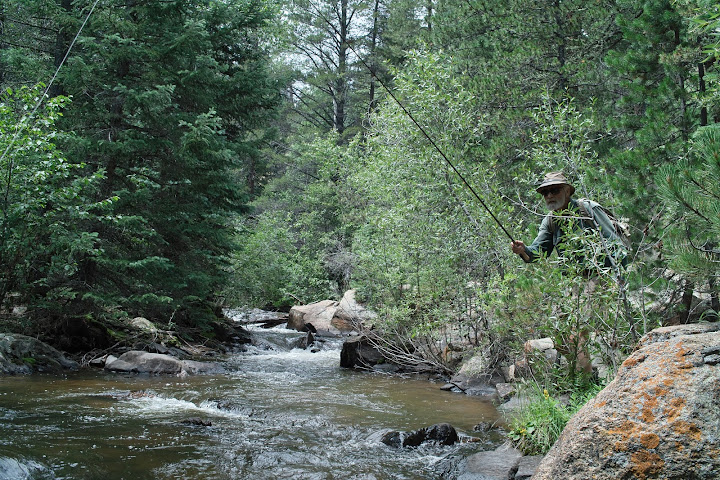
John Gierach hitting a nice pocket in a small mountain stream.
I think the Cutters and Gierach’s readers deserved to learn about tenkara. After all they often talk about mountain stream fishing, and how could you ignore tenkara when that is one of your favorite kinds of fishing? It’s awesome that they have been able to see why tenkara is here to stay.
New auction for Japan Relief Efforts
The first auction we held for the benefit of the on-going relief efforts in Japan was a huge success. We raised over $900 through the sale of a very rare authentic tenkara net.
Inspired by that auction, tenkara angler and owner of TrailLite Designs, Thom Darrah, approached us to do a new auction by donating one of the products he designed, the Ebira rod quiver, as well as a tenkara gear set. The new auction includes all items one would ever need to go fishing – a complete tenkara set:
– Iwana 11ft rod, Series II (147.95)
– Ebira rod quiver (55.00)
– Tenkara Net (85.95)
– Book: Tenkara, Radically Simple, Ultralight Fly Fishing. Dr. Kelleher and Misako Ishimura (Signed by Dr. Kelleher) (19.95)
– 3 flies tied by Dr. Ishigaki (the only fly he actually uses for fishing) (priceless)
– Level line 3.5 (12.35)
– Traditional tenkara line 10.5ft (19.95)
– 2X Line holders (11.95 each)
– Tippet, 5X (7.55)
– Forceps/Nipper set (11.95)
– Fly box (12.35)
– Tenkara tea set (15.00)
Keep an eye open, I just got wind that there is a very rare, authentic bamboo tenkara rod coming from Japan, donated by Dr. Ishigaki for a new auction. It’s a very nice gesture from him. It will be the first time an authentic tenkara bamboo rod will hit the market and will probably be the only chance to ever acquire one as they are rare even in Japan – I may bid on that one myself too 🙂
100% of the proceeds from these auctions go to relief efforts in Japan.
Tenkara Summit Artwork by Anthony Naples
The Tenkara Summit is picking up steam! A killer speaker lineup is secured, Dr. Ishigaki’s ticket to Bozeman has been booked, and many people have already registered – I’m wondering if I’ll have to reserve an additional conference room.
Now, to top it all off, tenkara angler and artist Anthony Naples, of the blog castingaround.com, has provided us with some delightful artwork to celebrate the first Tenkara Summit to be held in the US. A couple of weeks ago Anthony said he had an idea for a poster, and asked if it would be okay for him to take a shot at it. Of course! I’m very pleased with the results, and we’ll adopt his artwork as the official Tenkara Summit art. Anthony has setup a store on Zazzle, with the Tenkara Summit artwork below on shirts, posters, mugs, etc. We will have some shirts for sale during the event, but they will be in a very limited quantity. So, if you want to guarantee you get a shirt, you may want to order it from Zazzle.
Thanks Anthony for the beautiful work! I think it fits tenkara very well, and is a wonderful way to celebrate the event.
Iwana handle upgrade. Now available
If you purchased one of our Iwana rods prior to last year, you may now get the upgraded handle for your rod.
Based on feedback from anglers in Japan, we redesigned the handle of the first version of the Iwana rod, improving its length, contour and cork quality. Instead of buying a new rod for $147.95, you may simply get the upgraded handle for your rod for only $36. One of the many advantages offered by the design of tenkara rods. The upgrade handle is available here.

Authentic Tenkara Net Auction For Japan Earthquake Relief Efforts
You certainly heard about the tragic earthquake and tsunami that swept through Japan. I’m relieved to report that our tenkara teachers, friends and family are okay, but many others are not.
In an effort to raise funds for the relief efforts that will be taking place in the coming days/weeks/months, I am auctioning off one of my very prized and extremely rare tenkara nets (tamo), made in Gujo by tamo master Ikichi-san. I feel greatly indebted to the people of Japan for teaching me about tenkara, and for always kindly welcoming me. 100% of the proceeds will go to the relief efforts.
I have written extensively about tenkara nets here http://www.tenkarausa.com/blog/?tag=tenkara-net. I thought you, or someone you know may like the opportunity to acquire this one. 100% of the money raised will be sent to the relief efforts, and the bidder earns a one-of-a-kind net that is becoming rarer by the day. Please pass it on to anyone you feel would like a chance to bid.
Good luck with the bidding and than you for helping.
AUCTION (better pictures, and more info here): http://cgi.ebay.com/ws/eBayISAPI.dll?ViewItem&item=320670445593
Tenkara net gallery
It has been a while since I last posted som ething on tenkara nets. So, I thought I’d give you an update on nets that I have recently finished. Also, be on the lookout this year for more on tenkara nets. I plan on talking more about them, and the advantages they present for stream fly-fishing, particularly mountain stream fly fishing.
ething on tenkara nets. So, I thought I’d give you an update on nets that I have recently finished. Also, be on the lookout this year for more on tenkara nets. I plan on talking more about them, and the advantages they present for stream fly-fishing, particularly mountain stream fly fishing.
This first net was made with a Juniper tree branch, collected in Colorado. It is one of my favorite ones so far. As with all nets, this was a whole lot of work, but the beautiful features on the wood made it all worth it. I also incorporated a deer antler, which I thought would really complement it – and protect me in the water as Japanese superstition goes. As I didn’t want to hide the flaws on the branch, I chose to fasten the mesh to it by using eyelet pins on the bottom of the frame – TONS OF WORK, and I don’t plan to do that unless absolutely necessary as I felt it was for this one.
As with all nets I’m making, this one features my name with Japanese kanji characters on the handle. Dr. Ishigaki, my sensei, is also quite a master with words. He was able to find characters that can not only be pronounced “Da ni e ru”, as you’d pronounce my name in Japanese, but also mean “a person who developed his own casting style” or something to those lines.
The one below is made of a Ponderosa pine branch, collected in the Sierras. I made the hoop larger than most other nets so far. It is a little over 27cm (most that I make are 24cm) in diameter.
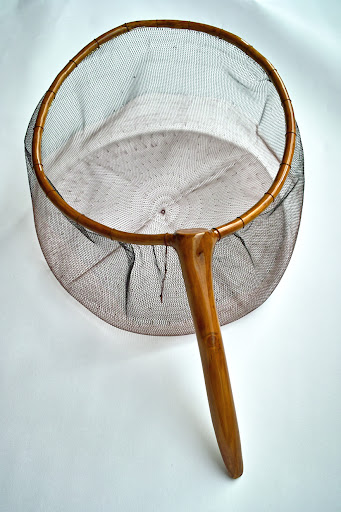
This one is a small net, made with Jeffrey Pine. The diameter of the branches making the hoop are thinner than usual, but it’s very strong nonetheless, and I’d use it with full confidence. The line used to connect the mesh to the frame was twisted polyester line made by my friend and forum user Rick.
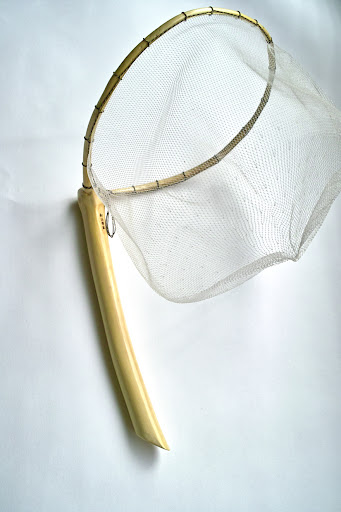
And, below is the “kuroi tamo”, a unique black net. The branch had some parts with interesting lines and features, but was generally boring and not that pretty. Thus, I decided early on to highlight the interesting features by darkening the entire net and having a transparent, and golden tone over on black on those features. They are hard to see in the photographs, but the bottom of the handle and the rounded middle are where you can see it. Unfortunately I think the mesh bag was too small for this one. I was going for a smaller mesh to keep its look more “delicate”, and used a 24cm size. I should have used a 27cm mesh, and will probably change it down the road.

Tenkara Flies of the Day II
Rick Setina tied the fly below and says “I chose the sakasa kebari with a black body and a red tail section. I used grizzly hackle because that color combination did so well last fall in the high sierra mountains of Mammoth Lakes. I try to make my flies fairly bushy as far as the hackle goes. I feel the more action the feathers produce in the water the better it attracts fish.” I think this would work very well on a fast flowing mountain stream as well.
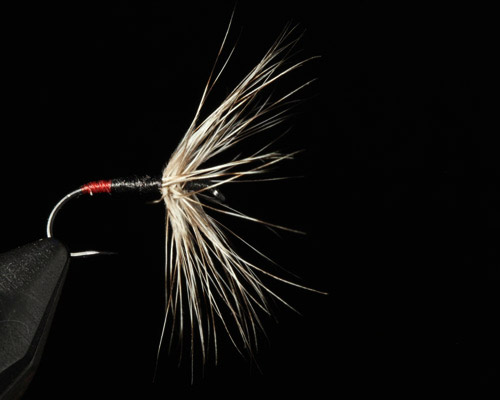
Tied by Rsetina
Erik Ostrander, who organized our first tenkara fly swap, created the midge tenkara fly below. Erik says, “For the second fly swap I tied a tenkara variation of my successful western fly called the “Drunken Midge”. It’s a very simple tie utilizing wine colored wire – hence the name. I have great success fishing this fly in the winter during the prolific midge hatches. I’ve been wanting to tie a good tenkara style version of the Drunken Midge for some time now, and I believe my design holds true to the original pattern. I call this one “Umeshu Midge”, named after the Japanese liquor made from Ume, the Japanese Plum. The tie is quite simple. Mustad C49S hook in size 18 to 22, gray uni-thread, wine colored wire, and a grizzly hen hackle.”

Tied by Erik Ostrander
Tenkara Summit
First “Tenkara Summit” : August 27th, West Yellowstone, MT! Read the rest of this entry »
Please visit www.tenkarausa.com
.
.
.
.
Please visit: Tenkara USA for fresh blog updates.
.
.
.
.
.
This blog is just a testing ground for Tenkara USA’s main blog.
Upstream or Downstream? One more point Angler Etiquette
The last post was based on the long-held discussion of whether it’s better to fish upstream or downstream. Thinking about it, made me discuss a few pragmatical reasons to fish upstream. I decided to ask Dr. Ishigaki why he likes fishing upstream, looking for more “scientific” reasons. But, instead I was reminded of an important reason that I missed: angler etiquette!
When we go fishing in a mountain stream, we are often looking for solitude. Not only that, but fish in smaller streams will often be spooked more easily and not take a fly if they have been disturbed. So, keeping other anglers in mind, as well as our own interest, the best approach is to have every angler fish in the same direction, upstream. This will ensure that anglers are not crossing each other, just to find the entire rest of the stream spoiled. It will also allow anglers to leapfrog each other if they see someone upstream.
I grew up surfing, and though I won’t discuss the etiquette of wave riding, and surfers tend to be quite different when it comes to protecting their water, they do understand clearly that some etiquette in the water benefits everyone. Sure, there are wave hogs, and most breaks are way more crowded than any stream I have ever fished, but everyone moves in one general direction and that helps keep people happy in the water.
Fishing upstream or downstream? The long-standing question from a tenkara perspective
Many times inspiration for our blog posts comes straight from the great community of tenkara anglers hosted in our forum. In recent days two threads were posted in our forum related to the idea of fishing upstream or downstream: “How do you prefer to fish with tenkara- upstream or downstream?” The forum threads are great because they present questions many of us ponder, but perhaps don’t bother thinking much about. They usually force me to think of “why”, sometimes providing some new insights. This post is basically my answer to how I tenkara fish, and why I fish upstream. Answering it made me realize that, even though there is a long-accepted theory that fish can see better if you approach them from upstream (that is, fishing heading downstream), I really don’t buy into it, but rather, fish upstream because of a couple of more practical reasons.
I think there may not be a wrong direction to fish as long as the approach is well planned, but as I will write below, I think fishing upstream has at least three advantages: (1) a good chance of not being seen by fish if you’re in a steeper tumbling stream, (2) greater ease at spotting stream features, and (3) a larger number of presentation possibilities.
A couple of weeks ago I went fishing with Ralph and Lisa Cutter, very well known and respected anglers. They own the California School of Fly Fishing. Ralph is most well known for his underwater studies of fish and bugs – he dives a lot and, with his years of research and experiments, knows what fish can or can not see. He said he always prefers to fish downstream. I brought up the idea, which I don’t personally buy too much, that fish would be able to see you more easily this way; he said that’s nonsense, fish have an almost 360′ field of view, with a very small blind spot directly behind them, but as they are constantly moving, swinging with the current, their actual field of view is 360′. The reason he likes to fish downstream is a practical one: he says he is a very visual angler, and can see the white in a fish mouth more easily that way and thus strike the hook when that happens.
Fishing downstream, features are harder to spot
I may understand the field-of-view reasoning for slower moving streams and flatter streams. However, when fishing in a steeper stream, even if fish may have a 360′ fov, one advantage of fishing upstream is using the geography of the stream to help hide you. In a steeper stream, it can be common to find large rocks upstream, and the natural “falls” and turbulence of the water can do their part on this too. On the same token, I think it is much easier to see features in the water when you’re moving upstream. if moving downstream all can blend in a bit more easily, features become “flatter” as the boulder breaking water above a spot will now hide it, you can’t see the whirlpool forming so well because the water dropping into it may be hiding it. I haven’t taken pictures with this in mind, but above this paragraph is a picture of a stream looking downstream on it. To me it looks relatively flat, and though I can’t see places where fish may be hiding, I can’t see them all that well. The picture below shows the contrasting image, the same stream but looking upstream, you can see a lot of features that may be holding fish. Not to mention that if you’re wading downstream, you could potentially step into a deeper pool without noticing it, but that is more easily avoided if moving upstream.
Fishing upstream reveals the stream features more clearly
My tenkara sensei, Dr. Ishigaki prefers to head upstream. I haven’t asked him exactly the reasons why he does so but will in my next email. He never fishes moving downstream. BUT, he frequently does fish straight across, and occasionally a little downstream too if he finds the need to, as he moves upstream. Because he prefers fishing upstream, his first casts will almost always be upstream. As he moves up he will often hit the same spot from two, sometimes three different directions if he believes there are fish there: so, upstream, 1/4, straight across. You can see a summary and illustrations of the main tenkara techniques in our past blog posts.

His general approach, and mine is: keep moving upstream, because we’re moving up our first casts will almost always be about directly upstream, with a drag-free drift of the fly. If there are features (small whirlpools/currents/etc) 1/4 upstream, then cast to those too. Try 3-4 casts in each of these directions. Now, you move up and the pool that used to be upstream or 1/4 upstream from you is straight across and you can try fishing that spot for a totally new angle and with new technique. By casting straight across you can manipulate the fly in different ways (stop the fly, let it drift, stop, let it drift; or stop, pick up, stop, pick up; or casting slightly downstream and move the fly upstream about 1ft at a time by pulling it. If you effectively covered the water on your way up, there shouldn’t really much of a need to fish downstream as the water has been covered.
Now that I write this I realize another reason to fish upstream may be that, with all things being equal – e.g. fish can see you well no matter which directions – by moving upstream you can hit the same spot with more fly manipulations/techniques.
If you move down stream, you can hit the pool downstream with essentially one presentation: stop, let it drift or any variation with drag, it’s difficult to achieve a drag free presentation this way without creating slack in your line; then as you move to the side of the spot, you can get a drag free drift but maybe not a great one; at this point it is no longer very effective to go downstream from the spot and try another presentation if the fish hasn’t striked, and you missed a chance to get a good drag-free drift over that spot. But, by moving upstream, I think you can get the drag-free drift first, and apply all other techniques effectively from the side of the spot, and perhaps a little upstream from it. So, you have now applied one extra, perhaps the most effective, technique.
Tenkara reaches Finland Interview with Tenkara USA founder
Finnish blogger and ultralight backpacker Hendrik Morkel, of the site “Hiking in Finland”, conducted a good interview with Tenkara USA founder, Daniel Galhardo (yes, that’s me, and another “ego boosting” intro 🙂 ). The interview covers several aspects of tenkara, and also focuses on the business side of Tenkara USA, and the vision behind it.
Excerpt:
Interview: Daniel Galhardo from Tenkara USA
“I love angling. I love Japan. So when I read about two years ago about Tenkara USA I knew immediately that it is something I need to try. Since then, I fished a few times with my tenkara fly fishing gear, and have kept a steady eye on the developments of the company. I always liked them, great videos, great website, great service. So I got in touch with the founder of Tenkara USA, Daniel Galhardo, and he happily agreed to an interview. If you’re not yet hooked on tenkara [pun intended], I bet you will be after this interview – enjoy!
Most current picture of Tenkara USA’s headquarter:

To read full interview, please visit Hiking in Finland
Book Review: Tenkara – Radically Simple, Ultralight Fly Fishing
It’s official, the first book in English about tenkara has been published! This is the great work of tenkara enthusiasts Kevin C. Kelleher, MD, and Ms. Misako Ishimura, and marks a huge milestone for tenkara in the US. It is an indication of the growing popularity of tenkara, and demonstrates once again its appeal to people with decades of fly-fishing experience like Dr. Kelleher and Ms. Ishimura. The book illustrates tenkara’s potential to introduce newcomers to fly-fishing via its “radically simple” approach, and shows how this method of “ultralight fly-fishing” has great appeal to backpackers. The beautifully illustrated work of Dr. Kelleher and Ms. Ishimura will do much to introduce people to tenkara, though it does blend some of the western notions of fly-fishing with tenkara, and shouldn’t be considered a definitive work on “pure tenkara”. The book is now available for pre-orders (though it seems to be already shipping) via Amazon and other retailers. Please read our review below.
Tenkara, Radically Simple, Ultralight Fly Fishing, is a nicely illustrated book that will do much to help introduce people to tenkara, and thus to the simple sport of fly-fishing. It’s important to keep in mind, however, that it is a blend of information about tenkara and western fly-fishing concepts, as opposed to a guide to “pure tenkara”, i.e. tenkara as it is and has been practiced in Japan. It unfortunately leaves out information on few areas of tenkara as it is practiced in Japan, in favor of western fly-fishing notions. Thus, it should not be considered the “definitive guide to tenkara” or the “tenkara bible”, but rather as a general introduction to tenkara and fly-fishing…
Field & Stream Fly Talk by Kirk DeeterFly Trends for 2011
Kirk Deeter and Tim Romano at the Fly Talk blog by Field & Stream magazine were some of the first to tell their readers about tenkara fly-fishing [though they have not yet talked enough about it]. Today I was very pleased to read their “Fly Trends for 2011”. The comments that particularly caught my attention were:
2011 will be the year of the small stream. Companies and shops are going to press the virtues of those small waters… the value of catching wild fish, though they might be modest in size, over the stocked mutants in crowded tailwaters.
So get out the 2-weight, the fiberglass wand, or the Tenkara rod, pull up the hip waders, and get ready for a small stream rededication.
In line with what many people have been saying (Mr. Gordon Wickstrom, for example), I think tenkara is at the forefront of a trend towards simplification, less reliance on unnecessary gear, and yes, mountain stream fly-fishing and small stream angling. We’ll see if this holds true; we were pleased with how some of the 2010 predictions made by anglers for Midcurrent came true.
The creation of a new product categoryTenkara fly-fishing in a graph
Tenkara USA created a brand new category, a new market, in the fly-fishing industry: tenkara (you may also call it “simpler fly-fishing”, “mountain stream fly-fishing” and a “great fly-fishing method for backpackers”). I suspect tenkara has probably been the most blogged about fly-fishing topic since our inception, and definitely one that has created a lot of discussion (sometimes pretty heated) among fly anglers. I can say that because I have a good finger on the pulse of the industry and, as a former market analyst, I have done a lot of research on my end (before I left my previous job and as I continue to grow Tenkara USA). But, hard data that I can share is hard to come by. As a proxy, and for something I can share with you, I decided to take a look at the historical searches on Google for the terms “tenkara”, and “fly-fishing”. I knew there would be virtually no searches for tenkara before we opened our doors, and wanted to see what kind of impact we had in creating this brand new product category.
While I’m typically not one to brag, it’s really cool to see how we have indeed created a new category in the fly-fishing industry and how the awareness of tenkara is slowly growing through our efforts and through the word-of-mouth of passionate new tenkara anglers. Before we “opened our doors”, tenkara was virtually unknown outside of Japan and the term basically never searched for. Few people even knew about it in Japan (see our radio interview with Tokyo radio station). Now, the number of people searching for the term “tenkara” is steadily growing. Take a look at the graph above for a search pattern graph, please note, this report only shows search patterns on a scale of 0-100, not the number of people searching the terms. Timeline: I first learned about tenkara in early 2007, and learned that “Tenkara Bum” Chris, was researching it at about the same time (thus the little bump in 2007 on the graph below). I then started seriously studying and developing Tenkara USA in September/October 2008 (suppose it takes at least 2 people to register on the search patterns). And, then “opened the doors” of Tenkara USA in April 2009. At this point I started working very hard on increasing the awareness of tenkara, and educating the public on the method. Bloggers have really taken an interest in tenkara and contributed much to its introduction. The big peak on the graph was in September, 2010, when an article on tenkara was published in the New York Times.
After seeing this graph I became curious to see how the searches for “tenkara” would compare to “fly-fishing”. Of course the absolute numbers for tenkara searches are a tiny fraction of the searches for “fly-fishing”, but it’s widely accepted the number of fl-fishermen has been declining. Do you want to see something very interesting? Look at the longer-term searches for “fly-fishing”. Research by one of the major fishing companies in Japan (which produces equipment for all types of sport-fishing) has shown that fishing in general has long been in decline in Japan just as it has been here, but tenkara has been the one category to have actually grown in Japan in the last few years. Through tenkara we hope to introduce many new people to the simple sport of fly-fishing.
Tenkara rod, Iwana redesignFeedback from tenkara masters
While Tenkara USA is a fully independent company with no commercial ties with a Japanese company, we are very fortunate to have established very strong relationships with tenkara masters in Japan. These relationships, particularly with our masters Dr. Hisao Ishigaki, Yoshikazu Fujioka and Sakakibara Masami (aka Tenkarano-oni) can be seen in every single one of our products, and is something no other tenkara company can enjoy. That is our true competitive advantage.

Today I’m happy to release our redesigned Iwana tenkara rods. The Iwana is currently our best-selling rod, and redesigning something that is working that well is always a risk. However, this rod incorporates meticulous feedback acquired from tenkara anglers in our last visit to Japan. The feedback was honest and important enough to warrant the tweaks we made. The main focus of this release was the new handle design. The handle is probably the most important design component of a tenkara rod. It provides comfort for a full day of constant casting and manipulating of the fly and balance to the rod. Our new design allows the angler to comfortably grip the rod in different positions, including the very end of the rod with a rounder finish. This new release also features better quality cork, a longer handle (unanimously suggested by all tenkara anglers we met in Japan for improved balance), and a redesigned metal cap which will not come loose while fishing.

Live interview for Japanese radio 東京ラジオ局J-Wave ・テンカラのインタビュー
I have suspected that the popularization of tenkara in the US would help create even more interest for tenkara fly-fishing in Japan. Today, Tenkara USA founder and CEO (yes, me, Daniel Galhardo) gave a live interview about tenkara for the Tokyo radio station J-Wave, in their program, “Global Frontline”. They were very interested in tenkara, particularly because most people in Japan still have no idea what tenkara is, but it’s being widely adopted here in the US.
The introduction is in Japanese, but the interview was fully done in English. It’s now available on iTunes as a free podcast. You can also listen to it on your iPhone, just search for “Global Frontline”. CLICK ON IMAGE BELOW FOR PODCAST LINK:
Tenkara USA interview for Tokyo radio station, J-Wave “Global Frontline”: http://itunes.apple.com/us/podcast/j-wave-jk-radio-tokyo-united/id322103767#
Tenkara techniques: Landing fish with long lines
Sometimes to improve our technique we must watch examples of how something should not be done.
Yesterday a video showing a tenkara angler in Japan using a very long line was brought up in our forum. The angler is probably using some 30ft of line, which is on the very long end of the scale for tenkara lines but still manageable. However, the video shows very poor landing technique for landing a fish with such a long line. In the Japanese video shown at the bottom of this post, the angler plays the fish much longer than necessary and instead of grabbing the line to bring the fish closer to him, he walks back up the bank and beaches the fish – A BIG NO! NO!
Correct way of landing a fish with a long line:

So that you know better, when you decide to use a line longer than your tenkara rod, the proper technique is pretty simple and consists of simply lowering the rod tip towards your back so you can bring the line closer to you, then grab the line and hand-line the fish closer to you. The video we produced last year and posted below shows decent technique, I have improved it since making the video: do not lift your arm high as I do in the video below at 1:40, you can keep your elbow bent while you calmly do bring the line and fish closer to you. Then, try bringing the fish to a place with calmer water so you can subdue him closer to you and calmly net the fish
OK technique for landing fish with long lines can be seen here (should have kept my arm lower, this gives more control of the line and of the fish and is less tiring):
17″ Brown recently landed using about 28ft of line:

THIS SHOWS BAD TECHNIQUE:
REPEAT, BAD TECHNIQUE – DO NOT TREAT FISH THIS WAY. READ REST OF POST ABOVE!
Tenkara techniques: Part 3 (sinking your fly)
Think about the origins of tenkara and western fly-fishing. Tenkara was originated by commercial fishermen, whose livelihoods depended on very efficiently and cheaply catching fish. Instead of spending time tying different flies on to the end of their line, or time and money making different patterns or making sinking devices, they relied on technique, learning how to present and manipulate their one fly. Most tenkara anglers will stick with one pattern only, and make it work with whatever situation they are presented with, even if it means they need to sink a fly without split shot or heavily weighted flies.
Many people believe they need to use a nymph, a heavy hook, or – UGH! – split shot to sink a fly. Casting a line with split shot is one of my worst nightmares, I have done it a few times and hated it. With some technique you can get your fly to sink between 3 and 6 ft, sometimes even more depending on the conditions you’re presented. While split-shot, or a heavy Czech nymph will get your fly to sink deeper and faster, I find them awful to cast and one more piece of junk to get lost in the stream or for you to carry, plus, moving one pool upstream will probably produce better results if no fish are taking. One question I get time and time again is how do you sink your fly with no weight?
The first thing you can try doing is casting a bit farther upstream, this will give the fly a chance to soak up more water and sink a bit. Now, here’s the cool technique for sinking your fly deeper in a mountain stream. It’s really a deadly technique, particularly useful when you find some white water, and you have tried a few techniques but no fish rose. Simply cast the fly upstream from the incoming white water (it doesn’t have to be a waterfall looking pool, simply a point with more turbulence). Let the fly drift into the white water, and then lower the rod tip almost all the way down to the water. The intent here is to get as much of your line in the turbulent white water, and get it to be sucked under. As the line gets dragged under your fly goes down with it. After a few seconds you’ll feel the line starting to move downstream, as it does you follow it with your rod, slowly and gradually raising the rod tip as the line goes downstream.
TIPS:
– Always strive to keep your line tight. This will allow you to feel anything taking the fly, or for you to see the line stopping/moving in an unusual way, which may mean a fish has taken the fly.
– Variation: As your line starts going downstream, and you start raising the rod tip, try raising the rod tip then dropping it about 10 inches up and down at a time. Every time you lower it you’ll need to wait a second for the fly to sink again. This is a great way to entice trout to take, and every small pull up may allow you to hook a fish if one is has your fly and you haven’t noticed it.
– Move your rod downstream and slightly forward with it to keep it from swinging.
– The technique works a bit better with level lines, which are denser than the traditional lines.
Tenkara techniques: Part 2 (not swinging a fly)
Two of the main goals to fly-fishing technique are attracting a fish, and getting the fish to actually take the fly. Dr. Ishigaki and other anglers in Japan have done many studies on these two aspects of fly-fishing, and have come to conclusions about the best ways to not only attract, but actually hook trout.
Western fly-anglers associate soft-hackle flies with a swinging motion, and thus many people new to tenkara have so far thought of it as a great method for swinging tenkara flies. However, there is a major flaw with swinging a fly: swinging moves the fly away from the where the fish expected it to be. Today’s technique is intended on fixing that. I learned this technique when I was fishing with Dr. Ishigaki in Japan and I complained that I was getting many fish to rise, apparently right on my fly but they weren’t “taking” it. He explained they seemed to be rising right on my fly but he could see they were just missing it and explained why.
When a trout is lying in its resting place, it’s keeping an eye on the food being brought by the current. In normal conditions, free-flowing insects (i.e. not attached to a line) will flow straight downstream. Except for very abnormal currents, they will flow in a straight line. When a trout spots food coming towards it, it moves in a straight line to intercept the food, in its strike zone. However, if the bug (your fly or a live bug) moves towards the shore, it also moves away from the fish’s strike zone. Sometimes the fish may be able to catch it, of course, but more often than not, a fish coming in a straight line upstream to intercept a fly will it if it has moved away from the strike zone. Have you ever felt like trout were rising right by your fly, almost right at it, but weren’t taking it? Many times it’s because they rose where the fly was supposed to be, but you pulled it away.
Next time, don’t swing your fly, try this instead: Cast just slightly upstream, or straight across. Stop your rod and let the fly flow downstream into its first natural position. Pause the fly in place for 1-2 seconds (depending on speed of current, among other things). Then, and this is where the change comes in, instead of keeping the rod tip in place, or swinging the rod tip toward the shore, actively move your entire arm downstream while pushing it slightly forward. Let the fly move about 1ft or a bit more, and stop the fly in place again for one or two seconds. And repeat, actively moving your entire arm downstream and forward. Stopping it in place is not absolutely necessary but will give fish a better chance to see it. 
TIPS:
– Stopping the fly in place will give fish a chance to see your fly and hopefully strike it.
– Repeat this 1 or 2 more times casting and stopping the fly exactly in the same spots. If no fish rises do it in a slightly different place 1 or 2 more times. If no fish, MOVE upstream.
– Start with your arm close to your body so you have room to move it forward (starting with the arm fully stretched will make this difficult)
– One important variation is keeping the main line in the water so the fly will stay right under the surface. To do this, picture the angler above holding the rod with his right hand. He’s holding the handle high above his head with his right elbow fully bent, and the rod tip almost touching the water on his left (so it’s pointing down). Similarly to this technique he’s also going to be moving his arm downstream and slightly forward.
Tenkara techniques: Part 1 (drag-free drift)
A post on tenkara fishing techniques has been long overdue. I have written many times about how relying on technique instead of fly patterns and additional gear is a good way to fish and actually learn how to fish. See “Confidence and Doubt”. It’s simpler this way, I like it. Relying on technique gives you the freedom to roam without consulting fly guides or concerning yourself with what may be hatching, or with what you should bring on your next outing to that far away place. You can fish with one fly all over the world, in any mountain stream you choose. While I hope to share these techniques in video in the future, I thought you may benefit with illustrations of the most common tenkara techniques in the meantime.
The first illustration is one that will be most familiar to you. It’s how most people fly fish already and is effective with tenkara too. One simply identifies where fish may be holding (think about places near enough a current that food is being brought to them, but where the water allows them to stay put without spending a lot of energy: behind and in front of rocks – even if these rocks are hidden under the surface – and on the seams of currents. With this technique one casts upstream from the spot, and lets the fly drift down as he lifts the rod in order to keep the line tight. As with most tenkara techniques you should strive to keep the main line off the water. Tip: when drifting the fly downstream one should not normally pull it, you must give the fish a chance to see your fly and grab it.
In the upcoming days we’ll be sharing the main methods of manipulating a fly with tenkara. While there are several different ways, and variations of the methods we’ll cover, the main techniques include :
1) Downstream, drag-free drift (today).
2) Cast, stop the fly, drift it downstream/stop/drift/stop
3) Cast downstream/pull fly/stop/pull/stop
4) Sinking the fly with no weight
5) Retrieving the fly, pulling it back across the stream.
6) Repeatedly casting fly in one place
Sanpei cartoon, tenkara episodes
It’s been a while since I have written anything on tenkara in this blog. To be honest, unless there is something I really feel like I need to share I won’t try taking your time. It may be good for SEO (to rank higher on google, etc), but if it’s not interesting there is no point.
One of the users of our forum just pointed out two episodes of Sanpei, the fishing boy I talked about in an older post, are available on Google videos. Unfortunately they are in Italian, but the cartoons as very well drawn and actually show relatively good technique. I’m not asking you to sit in front of them for the entire 20 minutes (unless you speak Italian and want to do it). But you may want to sift through them:
Episode 11:
http://video.google.com/googleplayer.swf?docid=3830024264957174244&hl=en&fs=true
Episode 12:
http://video.google.com/googleplayer.swf?docid=7855598312357321639&hl=en&fs=true
Freeing stuck segments
While Dr. Ishigaki was visiting he showed us a very cool method for freeing two segments that are stuck on a tenkara rod (or any telescopic rod). It’s very simple, and effective, particularly if you have pieces that are stuck very tight or one of the thinner segments is stuck. I still recommend the tapping method in the field or for most cases as that will normally take care of most cases. However, the rubber band should be used if you have a hard time freeing the pieces:
Tenkara nets now available.
I have said it before and will say it again, I have fallen in love with tenkara nets for stream fishing. After a lot of requests for us to offer tenkara nets and a long period spent developing nets that could be made with high quality and consistency, I’m proud to announce that our tenkara nets are finally available.
The best mesh for stream fish.
The super fine mesh of tenkara nets is absolutely ideal for stream fishing. Hand-made with nylon, the mesh has tiny 2mm gaps, which presents several advantages for stream fishing and until now have not been offered to anglers outside of Japan. The very fine mesh gently cradles the fish to minimize damage to its skin. A fish will never get caught in the gaps, as may happen in the wider gaps of some nets where the gills or jaw of fish can sometimes be damaged when they thrash around in other nets. It’s very light weight and retains no water (a quick shake will dry it entirely). And, my favorite, it will not snag your fly.
The best net design
Based on the original “design” of tenkara nets, which are made with one single branch and have a frame positioned at an angle from the handle, one couldn’t come up with a more functional design nowadays. The angle between the frame and handle can serve several purposes.
It allows you to position it on your back, through the wading belt ,while the net stays off your back and allows for free movement. When fishing in shallower water you can press it behind your knees after you net a fish so you can use both hands to manage the fish, or take a picture. If in deeper water, you can also leave the handle through your wading belt on your side as you have both hands free to unhook the fish or take a picture. The round handle also ensures you can position it between your legs, or the positions mentioned above, and it won’t turn. In sum, a very well designed angler’s tool and it has become our favorite picture-taking device.
For more information on why we love tenkara nets so much please see our blog posts on tenkara nets: https://tenkarausa.files.wordpress.com/2010/09/netuse.gif?tag=tenkara-net
We also offer separate mesh for the nets in case you want to venture into making your own tenkara nets.
Tenkara featured in the New York Times!!!
A major milestone for tenkara in the US. Yesterday an article on tenkara was published in the New York Times! It is inevitable that after the period of intrigue, and reluctance, tenkara would work its way to become a well established method of fly-fishing.
The article was very well written by Mr. James Card, who met with Ms. Misako Ishimura for a day of tenkara fishing. It talked about the story of its introduction to the US, with the participation of Tenkara USA and its founder (me), Misako Ishimura, Chris “Tenkara Bum” Stewart, and Dr. Ishigaki, of course.
Please take a look: http://www.nytimes.com/2010/09/16/sports/16tenkara.html?_r=1#
Tenkara Ouji
For the last several years the sport of fly-fishing has been threatened by decline, primarily attributed to young kids not taking up their parent’s and grandparent’s most soothing activity. As more experienced anglers, we try to engage young kids in the sport in the best way we can; last year Cameron Mortenson (from the Fiberglass Manifesto) and Kevin Powell started the website FishyKid.org, which has attracted many kids (and probably parents too) and is successfully keeping kids interested in the sport. Tenkara USA also sees itself as a great conduit to get kids involved in the sport, with “cool” telescopic rods, that are longer than their parents yet very lightweight, very sensitive and, importantly, easy to use. Our rods are being very widely adopted by parents wanting to teach their kids how to fly-fish, and from several reports, it is working well. To a certain degree tenkara changes the game by making it easier, and most importantly, less frustrating for kids to take up the activity. Give a kid a tenkara rod, and he will quickly figure out how to cast it, and most often quickly catch a fish too, thus “hooking” him for life. Of course, there is always the “Tsuri kiji Sanpei” comics to get their interest too.

It was with great relief that, while visiting Japan, we’d find a living proof that the young are still taking up the sport, at least via tenkara. During the tenkara event we got to meet young Taiga Watanabe, who was just about to turn 13. Taiga goes by the nickname “Tenkara Ouji”, translated as “tenkara prince”, and is well known for hanging out with the older “Tenkara Oyaji”, secretly picking up the masters’ tricks.

Tenkara Ouji showed us a tray filled with multiple tenkara patterns he tied himself, and which he sold like candy to anglers in the event. In an effort to foster his keen interest in tenkara, or perhaps to feed his insatiable appetite for cool tenkara gear, I put in an order for a few dozen tenkara flies. I knew anglers here would love to have them. His dad assured me Taiga would be tying flies through the summer anyways, so he may as well sell them to me so he could sustain his tenkara addiction. We shook hands and a few weeks later we received these beautiful flies. I kept a few for myself, and have caught plenty of fish on them. The rest are now available for purchase as sets, which include one of each of the flies pictured below. These flies wont’ last long, only a small number of sets is available. He’s currently tying new patterns for us, which should be available in a couple of weeks.
Tenkara Ouji's flies
Tenkara USA featured in Japanese magazine
This month Tenkara USA is being featured in the Japanese fly-fishing magazine, Fly Rodders.
Fly Rodders is one of the leading magazines on fly-fishing in Japan. The mention is very positive, mostly focusing on the fact that we’re now introducing the Japanese method of fly-fishing outside of Japan.
I have often wondered, and talked to a couple of people in Japan, about whether tenkara becoming popular in the US could lead to its further popularization in Japan. Often times people in Japan have looked at the US for trends, and someone told me Japan is about 2 to 3 years behind the US in fly-fishing terms…well, I say the US was at least about 200 years behind Japan on this one! So, I could be inclined to think even such a mention could be the beginning of more tenkara adopters in its home country too. Maybe that’s presumptuous, but I’ll just continue thinking it.


Tenkara with John Gierach and Ed Engle
How can I possibly start writing about a fishing trip with two of the finest anglers in the US, if not by repeating an older post that I must have been living a dream? And that, if not overwhelmed, I am still trying to believe that I actually went tenkara fly-fishing in the company of such well known anglers as John Gierach and Ed Engle! These are two of the guys who most shaped recent western small-stream fly-fishing. Yes, tenkara fly-fishing with John Gierach and Ed Engle!

I was never too surprised that Gierach and Engle became interested in tenkara. And not that surprised that they would take up tenkara, either. I had read their work before, and knew they were small-stream anglers and pursuers of fly-fishing simplicity at their core. I also knew we shared many perspectives and ideals about the sport. They would have to be drawn to the simplicity and effectiveness of tenkara.
Though not entirely surprising, fishing with such well known anglers as Mr. Gierach and Mr. Engle is indeed quite a privilege, and witnessing both tenkara fishing exclusively during our trip and embracing tenkara as the ideal method for stream fly-fishing, was nothing short of a spectacular. That I could present anything new to these guys is something I’m very proud of.
Gierach playing a brown trout using the Iwana rod on the St. Vrain (yes, he does seem to be reaching for the reel):

After being contacted by Gierach and communicating with him for a period of time, I finally invited myself to fish with him in his home waters near Lyons, Colorado. I figured, if Gierach writes about it, it’ll be set on stone, and thus I should share all I know about “pure tenkara” with him. It’s easy to overlook the real origins and techniques of tenkara as practiced in Japan for possible preconceived notions on tenkara, and I didn’t want that to happen. A few days before the trip, I learned we’d be joined by Gierach’s good friend, Ed Engle, whose work I also admired and whom I had contacted a bit over a year ago because of an article he wrote on fly-fishing simplicity, having as few elements between him and the trout, etc. There you go, Ed, only a rod, line and fly between you and that trout:

What I didn’t know until I arrived is that both Gierach and Engle have a bit more than a passing interest in Japanese culture. Both Engle and Gierach used to belong to a poetry group in their college days and were very interested in Japanese poetry, philosophy and culture. Engle had even studied Japanese and learned the Japanese brush painting technique of Sumie. Gierach has been cultivating bonsai trees for over 20 years, and had some truly striking bonsai in his living-room; in addition, Gierach also had done some very nice “Gyotaku” (the art of applying paint to a dried fish and transferring the fish’s details to paper), which now sit at the writer’s den – yes, it was cool to see where the magic happens. Of course, the main topic of our conversations was fly-fishing, but that they had an interest in Japanese culture was cool addition. I spent two full days fishing in their company, staying at Gierach’s home. This gave us a chance to talk much, and at length about fly-fishing, tenkara’s origins and techniques and many other topics of interest; the conversations didn’t stop unless it was before the morning coffee, or for fishing.
Gierach’s 20+ year old bonsai:

We fished a couple of different forks of the St. Vrain, Gierach’s famous home stream. What a beautiful stream. On our first day, we headed to the South St. Vrain, hiking down a trail past a picturesque lodgepole forest, and through a mossy trail. We took our time to observe juniper bushes that could become nice bonsai and, of course, also kept our eyes open for branches that could work as tenkara nets . I brought a tenkara net along to show it to them, and I think both of them really liked the concept. Their gazes now often shifted from trail to stream to trees as they walk around.


The point in the South St. Vrain where we started was pretty tight in places, making it challenging to cast, but we managed our casts and hooked some nice trout. As we fished, I tried demonstrating the main tenkara techniques: casting upstream and having a drag-free drift downstream, while keeping the line tight; casting slightly upstream, holding the fly in place for a few seconds, letting it go down about a foot and holding, repeating until the end of the drift; casting slightly downstream and pulling the fly upstream at about 1ft intervals; or simply casting upstream from the head of a pool, dropping the rod tip so the line would be dragged under, and effectivelly sinking the fly deep. The stream opened up a bit as we worked our way up the stream, and the St. Vrain became “tenkara-perfect”.

During our second day, we visited a more remote part of the St. Vrain, remote for a reason. This stretch required a serious 4-wheeler to get up there. For a bit over 4 miles Gierach skillfully navigated some treacherous terrain with large boulders one would think impassable. It was all worth it when we arrived at a lush verdant area, with a gorgeous “tenkara-perfect” stream running through it.
Ed working a nice pool, Gierach farther upstream:

The air felt moist and smelled of pine trees, my favorite type of place. We hiked for a few minutes through tall grasses, still a little wet from the previous days’ storms, and which had been flattened by what we assumed were moose. We later confirmed this assumption by finding some moose dropping. “If you see a moose, don’t piss it off!”, I was told, as if I would purposefully do that. As we fished, going upstream, we managed a nice pace, leapfrogging each other to the next pool. I tried taking pictures in between, and every once in a while we’d reconvene, to either talk about the fishing, or to observe each other trying to fool a trout. Those were memorable moments.

Neither of them really went for the “ one-fly” approach that I have adopted, and primarily used a two-fly rig (elk hair caddis and a dropper nymph). Nevertheless, we did very similarly in numbers of fish each of us caught (discounting for the time I focused on taking pictures instead of keeping my “one fly” in the water). I was happy to see that they didn’t bother changing flies when the fish didn’t bite, focusing instead of moving upstream to the next pool, a classic tenkara approach.

Both Gierach and Engle agreed that any one fly pattern would probably work just fine in a stream like that. And so it did. I continued using one tenkara fly only, or more accurately, any fly picked at random from my box, which probably had 3 different tenkara patterns with a few different colors.
The fly resting on the flat part of my tenkara net:
The two newest tenkara converts will probably be letting their reels rest for a while. I won’t blame them if they choose to take their cane rods to the water every now and then, but for some reason I suspect that will not happen so often going forward.

GEAR USED:
A conversation with Ishigaki sensei
Ishigaki sensei and Chikara helping with translation
After knowing Ishigaki sensei for about a year and having had many communications with him via email, and after spending several days talking and fishing with him while visiting Japan, I thought there were some questions I should ask him “for the record”. An interview was in order. On the 3-hour drive back from the Itoshiro to Nagoya, I turned on the recorder and had a nice conversation with Ishigaki sensei. We had so many other lengthy conversations in my time there, and we covered many specific aspects of tenkara, this time I had some slightly broader questions to ask him.
NOTE: Ishigaki sensei gifted us with a few tenkara flies he tied himself, which are now available here for the benefit to an environmental non-profit.
CONVERSATION:
Daniel: Dr. Ishigaki, could you describe your path to tenkara? What led you to pursue this simpler way of fishing? What is your story with tenkara?’
Ishigaki sensei: I first learned about tenkara through a book, “Keiryu no tsuri” (stream fishing). The book was published about 40 years ago by the company “Tsuribitosha”. This book covered 3 types of fishing: lure fishing, live bait fishing and tenkara. Read the rest of this entry »
Manzanita tenkara net
Today I completed my first own tenkara net. It’s made of one manzanita branch, found after much looking and worked on for over a month. The end of the handle features a deer antler tip, which in Japanese superstition is believed to protect anglers in the water.
Raw branch:

MORE PICTURES Read the rest of this entry »
Tenkara tamo, the experiment continued!
I have been having tons of fun searching for the appropriate branches and then embarking on the adventure of making my own tenkara tamo (tenkara nets). As stated, I have fallen in love with tenkara nets!
After spending a few weeks looking for the ideal branches, I was able to find a couple of branches, one from a manzanita bush, the other from the Jeffrey pine. After near a month in the making, I’m getting close to finishing them. The entire process was documented on the forum. Here are the semi-final results.

I loved working on something so simple and aesthetically pleasing. It’s not easy, but doable, and beautiful. The details were difficult, especially joining the two arms of the frame.

Though all nets are unique and one-of-a-kind, the manzanita will be more so because the manzanita does not have the symmetrical branches with the right diameters and angles for a net. The Jeffrey pine, on the other hand, has the ideal shapes and the wood is easier to work with.
I’ll venture to say this is the first manzanita net frame in the world built in this manner, and after studying the manzanita I think it may continue with that title since it was almost impossible to find the right branch for it. It’s my most rewarding project, the wood is absolutely gorgeous, and the outer layer of the stripped bark is red, giving it a beautiful natural color and providing for very interesting patterns on the places I needed to strip and sand. I needed to cut the end of the handle as it was curved in the wrong direction, and I figured I could follow the tenkara tradition of using deer antlers for protecting who uses it in the water. A tenkara enthusiast, who also gave me some great advice, offered to send me some deer antler, and one of them was a great match, having almost the same colors as the wood itself.

Stay tuned for the final pictures in a couple of weeks.
Tenkara master, Dr. Ishigaki, to visit California
At the invitation of Tenkara USA and The Golden Gate Angling and Casting Club (GGACC), GGACC is proud to host renowned tenkara fly-fishing master, Dr. Hisao Ishigaki, for a unique cross-cultural fly-fishing event.
WHEN: Saturday, September 11, 2010
1:00 PM – 4:00 PM
WHERE: Golden Gate Angling and Casting Club, San Francisco, CA
 Dr. Ishigaki is known and deeply respected throughout Japan as the leading authority on tenkara fly-fishing. A professor in the field of vision studies at the Aichi Institute of Technology, in Japan, Dr. Ishigaki became first known among tenkara anglers for his research on the vision of fish and of anglers. He has dedicated a big part of his life to introducing this simpler method of fly-fishing to people throughout Japan via many books, articles and DVDs on tenkara. After his first presentation in the Catskills, NY, Dr. Ishigaki is now coming on his second visit to the US to speak about tenkara.
Dr. Ishigaki is known and deeply respected throughout Japan as the leading authority on tenkara fly-fishing. A professor in the field of vision studies at the Aichi Institute of Technology, in Japan, Dr. Ishigaki became first known among tenkara anglers for his research on the vision of fish and of anglers. He has dedicated a big part of his life to introducing this simpler method of fly-fishing to people throughout Japan via many books, articles and DVDs on tenkara. After his first presentation in the Catskills, NY, Dr. Ishigaki is now coming on his second visit to the US to speak about tenkara.
A very friendly and warm angler and engaging lecturer, Dr. Ishigaki says he’s looking forward to making many new friends in the US, and is looking forward to his visit.
During the event Dr. Ishigaki will do a tenkara fly-tying demonstration, a presentation about tenkara, and a demonstration on tenkara casting.
Space is very limited.
Those interested should RSVP at the GGACC website: http://ggacc.org/p/ViewEvent.aspx?eid=322
Tenkara for veterans
Fly-fishing is one of the most therapeutic activities around, and tenkara’s simplicity perhaps even more so. Since the inception of Tenkara USA, we have been approached and supported numerous organizations that work with war veterans and people with limited arm mobility. Tenkara, with no reel, no unnecessary amount of line to strip, no bells-and-whistles, has proved to be a very effective tool in helping people that would otherwise have difficulties, give fly-fishing a real try. It’s not the only tool around for adaptive angling, but definitely a fun tool that also provides some additional independence to those who want to fish with a fly. A fishing method made for fishing with one hand.

Tenkara removes the complexities that were added to fly-fishing over the years and makes it a fun, and above all, simple and intuitive method of angling with a fly. Not having to pass line through the rod guides, strip line to cast, and going through a complicated series of knots, mean that tenkara allows for greater independence in his fishing. Imagine you only have one able arm and want to setup your rod and fish, yourself, for a bit. A rod with a reel by default ask for two hands, frustrating, I’d imagine. As I witnessed, a telescopic tenkara rod is a rod, made for one-handed fishing. It can be held under one’s arm as the plug is removed and the tip is exposed with the able hand; the hand, which in turn quickly makes a girth hitch on hisline and tightens it against the rod tip. And, finally telescopes each segment of the rod out and proceeds to cast, an intuitive cast with no 2-handed stripping needed. These are the few steps needed to setup and fish with a tenkara rod when the fly is already tied on. I was extremely proud to see a tenkara rod, one which I adopted from a foreign country and introduced to the US, serve as much more than a simple fishing tool.
Walking around the banks of this lake, with his western fly-rod already rigged but mostly inside the reel, the war veteran – not only a war veteran but a western fly-fishing “veteran” of 3+ years, who, through a special reel, a special stripping device and some ingenuity – spotted a very good fish. With no time to spare and go through the process of getting his line out of the reel to cast, I gave him my tenkara rod, which I kept rigged for the occasional cast. Not yet fully used to casting with a tenkara rod, his first cast piles up a bit, but it’s no problem, the line is so light the fish was not disturbed. On the second cast the fly didn’t turnover completely, but went far enough, maybe 15ft out, to attract the attention of the feeding fish. In a few seconds it was fish on. A healthy and very feisty 14″ rainbow. Not his biggest, nor his first, but his first on a tenkara rod, maybe the first that provided such a fight he thought he may not actually land it, the first that perhaps felt like an equal adversary. But, also the first fish he had full control over, who didn’t take line, because he couldn’t, and after a very strong fight just surrendered because he realized he couldn’t really run anywhere. He was hooked. The simplicity of it, the fact that he could simply cast when he wanted to, and the won battle – All worth it.
A HUGE THANK YOU TO ALL VETERANS AND THOSE WHO SACRIFICE SO MUCH FOR THEIR COUNTRY!
Tenkara USA's tweets of the week
- A big tenkara WOW: http://bit.ly/bestAK. Wow! Don’t do this at home, really. #
Tenkara nets, an experiment in making one
I told you, I have fallen in love with the simple, organic elegance of tenkara nets. Though I have very little experience with wood work, I have decided to embark on the journey of making one. I have spent weeks looking up at trees trying to find the perfect branches to make a net myself. The branches needed to have just the right angles, the right diameters, be on the right (i.e. healthy) tree, in the right (i.e. legal) location, and be the right wood for this, that I just thought it was going to be impossible to ever make one myself.

Tenkara net, with a manzanita branch
I finally found a couple of branches that just may work, and if nothing else are good places to start the learning process. Through several resources accumulated and the suggestions of people with experience in wood work, I think I may just get to make my own net. I am documenting the experience on our forum, under the newly created category of “tenkara nets”. I was able to find 2 branches of a Jeffrey Pine (this yielded 4 possible nets) and one branch of a manzanita (above). So far I started drying the nets while forming them into shape with strings, removed the bark and did some initial carving on the knots and ends. Now I must let them dry for a while before resuming the work.

The raw net frame assembly.
This is going to be a real fun project.
Japanese fishing magazines
It had been quite a while since I was last excited about fishing magazines. With the exception of a couple of magazines’ recent issues that brought something authentically new (yes, tenkara classifies), very valuable local information, or some very cool imagery, most magazines that came to our office were, well, not kept.

The Japanese magazines I found in tackle shops in Japan depicted more than just an enormous fish on the cover, more than that exotic, expensive, and “unnatainable” large fish from “a distant Shangri-la. These magazines focused on showing a way of living, the angler/adventurer lifestyle, one that can be attained by anyone so inclined, and in turn excites those who look at their pages. These magazines, in my view as a long-time fishing magazine reader, invite someone to give fishing a try. Even not being able to read the language, they offered enough (diagrams, illustrations, maps, pictures) to get me to buy a couple of admittedly very expensive magazines – the fishing magazines cost as much as $18, but each one is like a book, with less advertising than magazines here. Would you pay that much for a magazine?
Tenkara has been credited with introducing many people to the sport of fly-fishing. It’s simpler, less intimidating, more attainable, and we shall say more enjoyable and effective too. The sport fishing industry has long been complaining of decline. I think magazines have an important role to play in introducing people to “simple fly-fishing”, the attainable lifestyle that anyone may choose to pursue. Instead of intimidating those who look at them in bookstores, I think our magazines would offer real value to the industry and to their readers by offering prospective anglers better content (yes, I’ll say tenkara again as an example, as opposed to the “coolest new bobber/ splitshot in the market”), and a simpler alternative to what is out there. Show novices that fishing really is simple, tell them ideas of where to go, and they will try it.
A huge fish on the cover can be cool, sure. And, there are some Japanese magazines that show the “monsters” on the cover, the big bass, the huge salmon, etc. However, the cover can show more than just that huge fish that has become a cover formula. I don’t believe that’s what most fly anglers are after, at least not on every issue. I for one am after real knowledge, real angling experince local content, cool stream imagery. The magazines I saw bring their audience real knowledge and cool imagery, a lifestyle, not just a distant dream.
Tenkara nets
I have absolutely fallen in love with tenkara nets (tenkara tamo in Japanese). As I got to see many examples up close, and learn about how they are made, and about their design, I realized tenkara nets are just masterpieces of simple organic, yet functional design. Each net is a work of art and I’m surprised I haven’t run across one at a museum somewhere. True, I haven’t been this excited about something since I discovered tenkara rods.
One of the main reasons for their appeal is the fact that tenkara nets are made out of a single branch of a tree. How much simpler can it get? No carving, no manufacturing, a simple, organic, tree branch selected and used to make a strong, and functional net frame. Of course, simplicity doesn’t always mean easy, and in this case it definitely does not. A good tenkara net is very hard to make, and it takes a long time to finish.
The process of making a real tenkara net starts with the selection of the wood; this is the most important step, and the defining one in the process. A tenkara net craftsman will spend days walking in the woods in search of the branches that will work well for making a net. He’ll look for just the right branch with the right angles and diameters. After I learned how these nets are made, I have spent a lot of time looking up to trees, trying to identify those branches that may offer the right angles for a net, and they are really not easy to come by, at least not to the untrained eye. As a result, every single net will be a completely unique piece, with lots of effort put into each one.
Traditionally tenkara nets are made with branches from the kaya tree (Torreya nucifera), a relatively rare type of conifer tree found in southern Japan and an island in South Korea. The trees are a protected species; they are slow growing trees, confined to a small area; thus, any branches that are found are even more highly prized. While I believe many other trees may work, the kaya seems to be ideal for these nets, it’s durable and hard yet lightweight, the wood has interesting patterns and a uniform grain. One of the nets I purchased, a slightly “large” one with a longer handle weighs a mere 3.5 oz. Occasionally bamboo is also used, though bamboo is not as durable for this application, and more difficult to work with, so makers tend to prefer wood branches.
In Gujo, Gifu prefecture, we visited a shop that specializes in tenkara nets. The store is run by the artisan and his wife and almost all nets are made by him. It is one of the few places in all of Japan that makes and carries thems. It’s a wonderful display of unique and authentic tenkara nets, some simple and functional, some with unique wood features, and some featuring ornamental deer antlers, which are said to protect anglers in the water. Yes, I did feel like a “kid in a candy store”.
The design and features of a tenkara net
Tenkara nets are just perfectly designed, even though no one ever really designed one, and even though I’ll suspect no tenkara net is never really “perfect”. As a matter of fact, imperfections are more than welcome on the nets, there is no need for the frame to be perfectly leveled or for the wood to be free of “flaws”. This may actually be their allure. The natural aspect of each branch is fully embraced by the maker, and by the angler. I think the concept of wabi-sabi applies well here. I have always been a big fan of Japanese design, and with so much inspiration from all aspects of life, even fishing, it’s no wonder Japanese design tends to be so clean, and functional.
The round shape of the net comes from the way the nets are made. Essentially one gets a branch that is Y-shaped (normally a trident shape, where the middle branch is cut off), and through a process of drying and steaming the wood, as well as forcing it into shape, bends the net frame into a circle. The reason for a circle shape is simple, a circle is the strongest shape that can be made to receive pressure or hold weight. Thus, a good circle is also a good indicator of the quality of the net. The circular frame is the best shape to uniformly distribute the pressure a fish puts on the frame, as well as on the net mesh.
The angle between the net frame, and the handle, is also an important functional attribute. As I experienced, this angle is supposed to help in a few ways. When wearing a wading belt (or a regular belt for that matter) the angle keeps the mesh and frame off one’s back, thus allowing the angler to move freely as he walks or climbs over a rock.
Further, the longer handle usually found on a tenkara net along with that angle allows for the handle to be held behind the knee as one is kneeling on the water, while having the net and fish facing slightly forward. This allows for the tenkara angler to have both hands free as manages the fish, removes the fly, and yes, takes a picture. If one is wading a bit deeper, the same may be done by having the net held by the wading belt, or even under the arm pit as he manages the fish at a comfortable angle and with both hands. Yes, ingenious design!

Click below for some very instructive web pages (in Japanese) on making the nets.
Learning tenkara with the masters, trip to Japan
FOR CONTINUED UPDATES ON OUR TRIP TO JAPAN (DAILY UPDATES), PLEASE VISIT:
http://www.tenkarausa.com/blog/
I just landed back in San Francisco a few hours ago. I find myself a bit dizzy from all the travelling and the jet-lag. And, to be honest, my entire experience in these last 2 weeks has just been so beyond my expectations that it is a bit overwhelming trying to digest it all. But, I figure I have to start somewhere. I plan to slowly publish my experiences, techniques I learned, new insights, interviews, videos, and anything I can share with you.

Daniel with an Amago
Maybe it was growing up watching Karate Kid and other martial arts movies where the pupil goes off to live in a remote mountain village in Asia to train with a well-known master, but for many days I felt like I was living a dream that had been engrained in my mind from my early years, the stuff of a movie. Now that I think of it, it is natural it would be fishing, not martial arts, that I’d be pursuing knowledge of. A couple of days ago my mind brought back the memory of fishing with my dad, watching someone catching a lot of fish, and my dad telling me that if I wanted to learn how to fish I should ask a Japanese person how he does it – the region I grew up in has a very large Japanese immigrant population, and there has always been a stereotype held by my dad, possibly a fact, that the Japanese were incredible anglers. Many years later I am blessed to have the opportunity to go to Japan specifically to learn tenkara directly from the master, Ishigaki-sensei, as well as many other very gifted anglers such as Yoshikazu Fujioka and Sakakibara Masami (aka Tenkarano-oni). I may be the first westerner to have ever received such in-depth focused training in the art and techniques of tenkara. For most of the last 2 weeks I was taken under the wings of the most renowned authority on tenkara in Japan, Dr. Hisao Ishigaki (hereby referred to as Ishigaki-sensei, as he has become my de facto teacher). I learned more about pure tenkara than I could ever have imagined I would.

Ishigaki sensei focusing on the water
Iwana
Daniel, Ishigaki-sensei, Fujioka-sensei, Chikara
Sakakibara Masami (aka Tenkara no Oni)
I spent many days fishing with Ishigaki-sensei: observing, learning, being observed and unequivocally taught. I also met some of the most well-known people in the world of tenkara at in Japan and was extremelly welcomed by the anglers and communites of the Itoshiro and Mase (Masegawa) rivers: being interviewed a couple of times and appearing at a local newspaper. I was also received as a guest of honor at the “Itoshiro Fisher’s Holiday”, an annual gathering cellebrating the beautiful Itoshiro river, one of the first “Catch-and-Release” rivers in Japan, and even gave a brief speech at one of the biggest tenkara events in the country.
Saitou Shouichi, one of the event's founders and organizer
Angler's barbecue - very well organized
During the event I sought feedback from many people present, and Tenkara USA’s rods, lines and flies were carefully reviewed by some of the most demanding tenkara anglers in the world, dully critiqued (which will only make our rods even better in the future), but an attestment to our products, they received a big nod of approval by people who take tenkara very seriously! Receiving this type of feedback is extremelly valuable, and I’m grateful to have made those connections.
A few of the things I plan to write about in coming days are:
– Interview with Ishigaki-sensei: We spent many hours driving around and having very in-depth conversations about tenkara in the car. These conversations allowed me to ask some questions that bring out a lot of insight and philosophy from the master, as well as the modern history of tenkara in Japan and other things. He also discusses his scientific experiments on fish and anglers.
– Tenkara nets: Japanese design has yet to disappoint me, specially when it comes to its “practical simple elegance”. I have not been so enamoured with something since my “discovery” of tenkara rods. Being in the center of tenkara in Japan, I was able to learn quite a bit about tenkara nets, and their extremelly simple nature, and very organic design has left me in awe, which I hope to share with you.
– Tenkara flies: The simplicity of tenkara is summed by the fact that all you need is a rod, line and A fly. More commonly than I had thought almost all tenkara anglers use one pattern only (whatever their chosen one is). It is very common practice among all tenkara anglers to rely purely on their techniques to find and entice fish, not on changing flies. At this point I have become a firm believe in this approach on faster flowing streams. While anglers will debate which fly works best – some may prefer a fly tied using the skin of a poisonous snake (more on this later), others may use the natural dubbing from the flowering fern (zenmai), and others may just use cheap thread and a simple hackle – it’s widely accepted that one fly is all you need.
– Fishing techniques: The techniques used in tenkara are generally simple, but they are the main pillar of tenkara fly-fishing. Technique, not gear, should be the focus of any activity, although modern society has tended to put a premium on the latter. Relying on gear, even on changing fly patterns, not only detracts from the experience, but also from one’s growth as an angler. I plan to share the techniques I learned in Japan, they work on any faster flowing stream. And, anyone can do well with them and one fly.

– Tenkara bamboo rods: You used to think split-cane rods are nice, well, I’ll tell you, tenkara bamboo rods crafted by a good craftsmen, are just masterpieces. I have next to me what are probably 2 of less than a handful of tenkara rods outside of Japan, and they are just sweet, simple crafts. Made by Dr. Ichi Hashi, a Pediatrician in nearby Gujo, they are wonderful works. Why split something that works so well as given by nature?
– Landing fish technique: While very intuitive, the big lessons here were slow it down! Bring the fish to a shallower part of the water. Let it calm down by holding the line (trust the tippet) and net it. No more lost fish at the last second.

Iwana
– Travelling and fishing in Japan: Japan is likely the best country in the world for small stream fishing. Many people I talk to say their first love is small stream fishing, but if they ever travel is to pursue big fish in tropical countries. Japan is a wonderful country to experience, and the small stream fishing there is top-notch. I’ll try sharing some advice.
Tenkara bamboo rod
There is something to be said about using a natural material as a tool. Particularly if this is simply crafted. Particularly if the focus is not on manufacturing it, but on selecting the best, most natural and suitable material there is, and simply touching it up to make it a long-lasting tool. Such is the tenkara bamboo rod, as well as the original tenkara net (more on this later). Non-split, non-manufactured, very rare, just incredible.
Dr. Ichi Hashi, tenkara bamboo rod maker
I had briefly seen a tenkara bamboo rod when Ishigaki sensei visited the Catskills last year, and I had read about it, but had not, until now, had a chance to feel a real tenkara bamboo rod. Then, I got to feel each of a group of some 12 rods, “feel them and pick the one that fits you best”, said Dr. Ichi Hashi, a local pediatric doctor who has been crafting tenkara bamboo rods forseveral years. What? Pick one? How could I? These are just incredible. But, how can I possibly say no and mean it? I had to feel the rods, I found my match, or as the cliche goes, it found me. All I could say was “domo arigatou gozaimasu”, while bowing very deeply for such generous gift, and hoping a gift of a hat and shirt could express a little gratitude.
Gorgeous handles, made of natural bamboo, or wrapped.
These are not the usual cane-pole rod. Yes, they are cane, but their action, weight, balance, are all those of a fly rod. The tenkara bamboo rods are made with 3 or 4 pieces of bamboo. Each rod uses 3 different species of bamboo, selected to be used as the rod butt, the middle of the rod, or for the tip. Plus the handle, which is often made from bamboo rhizome (roots). The selection and matching process is long. Dr. Ichi Hashi goes on his “expeditions” to the hills of Gifu prefecture, not far from Gujo, and selects the best bamboo for his rod. He does this during the late fall/early winter, when the humidity level in the bamboo is at its lowest. Then, he’ll dry the bamboo for up to 2 years in the attic of his clinic. At that point he’ll match the bamboo pieces to be used for the different segments of the rod. He’ll then clean the inside of the rod, opening the nodes to allow the thinner pieces to slip in; he’ll wrap the ends of the segments to strengthen then and lacquer them. And, finally, apply his mastery to finishing each rod. It’s pretty incredible that his rods look like they are all made from one single bamboo, the nodes often look identical, and the taper is flawless.
Incredibly, the nodes of these rod were perfectly aligned. A hard feat.
A 4-piece rod. Pieces are alternated to fit inside a thicker one.
Dr. Ichi Hashi also enjoys fishing with his bamboo rods the most, and I can see why. They are generally slower rods, but like our tenkara rods they come in a variety of flavors, there are the very thin/light rods that are soft (5:5) and there are those that feel stiffer/faster (6:4 or 7:3) , there are some rods that are slightly heavier, but can also be slow (5:5) or faster (6:4 or 7:3). Regardless of their action or weight, one striking feature of bamboo tenkara rods is their recovery. This is also different from the good’ol’cane pole. Since a tenkara bamboo rod is made for casting a line, the bamboo selected and used for them has great recovery. When you shake them (e.g. cast) the rod will flex as much as it’s made to flex, but it will recover and stop shaking promptly, thus it does not dampen the cast.
Dr. Ichi Hashi has extended me a serious invitation to come spend time with him learning how to make tenkara bamboo rods. There are not many people who make these nowadays. After feeling these rods, I believe there is a lot to be learned from them that can and should be applied to modern rods. Plus, how could I say no to that, when at 14 years old I was trying to learn how to select bamboo to make a cane-pole? Dr. Ichi Hashi, please expect me in Gujo again in the near future. And, domo arigatou gozaimasu.
To learn more about bamboo rods (is this a tenkara rod? and the point of divergence), click below.
Read the rest of this entry »
Tenkara bamboo rod
There is something to be said about using a natural material as a tool. Particularly if this is simply crafted. Particularly if the focus is not on manufacturing it, but on selecting the best, most natural and suitable material there is, and simply touching it up to make it a long-lasting tool. Such is the tenkara bamboo rod, as well as the original tenkara net (more on this later). Non-split, non-manufactured, very rare, just incredible.
Dr. Ichihashi, tenkara bamboo rod maker
I had briefly seen a tenkara bamboo rod when Ishigaki sensei visited the Catskills last year, and I had read about it, but had not, until now, had a chance to feel a real tenkara bamboo rod. Then, I got to feel each of a group of some 12 rods, “feel them and pick the one that fits you best”, said Dr. Ichihashi, 市橋 寛, a local pediatric doctor who has been crafting tenkara bamboo rods forseveral years. What? Pick one? How could I? These are just incredible. But, how can I possibly say no and mean it? I had to feel the rods, I found my match, or as the cliche goes, it found me. All I could say was “domo arigatou gozaimasu”, while bowing very deeply for such generous gift, and hoping a gift of a hat and shirt could express a little gratitude.
Gorgeous handles, made of natural bamboo, or wrapped.
These are not the usual cane-pole rod. Yes, they are cane, but their action, weight, balance, are all those of a fly rod. The tenkara bamboo rods are made with 3 or 4 pieces of bamboo. Each rod uses 3 different species of bamboo, selected to be used as the rod butt, the middle of the rod, or for the tip. Plus the handle, which is often made from bamboo rhizome (roots). The selection and matching process is long. Dr. Ichi Hashi goes on his “expeditions” to the hills of Gifu prefecture, not far from Gujo, and selects the best bamboo for his rod. He does this during the late fall/early winter, when the humidity level in the bamboo is at its lowest. Then, he’ll dry the bamboo for up to 2 years in the attic of his clinic. At that point he’ll match the bamboo pieces to be used for the different segments of the rod. He’ll then clean the inside of the rod, opening the nodes to allow the thinner pieces to slip in; he’ll wrap the ends of the segments to strengthen then and lacquer them. And, finally, apply his mastery to finishing each rod. It’s pretty incredible that his rods look like they are all made from one single bamboo, the nodes often look identical, and the taper is flawless.
Incredibly, the nodes of these rod were perfectly aligned. A hard feat.
A 4-piece rod. Pieces are alternated to fit inside a thicker one.
Dr. Ichi Hashi also enjoys fishing with his bamboo rods the most, and I can see why. They are generally slower rods, but like our tenkara rods they come in a variety of flavors, there are the very thin/light rods that are soft (5:5) and there are those that feel stiffer/faster (6:4 or 7:3) , there are some rods that are slightly heavier, but can also be slow (5:5) or faster (6:4 or 7:3). Regardless of their action or weight, one striking feature of bamboo tenkara rods is their recovery. This is also different from the good’ol’cane pole. Since a tenkara bamboo rod is made for casting a line, the bamboo selected and used for them has great recovery. When you shake them (e.g. cast) the rod will flex as much as it’s made to flex, but it will recover and stop shaking promptly, thus it does not dampen the cast.
Dr. Ichi Hashi has extended me a serious invitation to come spend time with him learning how to make tenkara bamboo rods. There are not many people who make these nowadays. After feeling these rods, I believe there is a lot to be learned from them that can and should be applied to modern rods. Plus, how could I say no to that, when at 14 years old I was trying to learn how to select bamboo to make a cane-pole? Dr. Ichi Hashi, please expect me in Gujo again in the near future. And, domo arigatou gozaimasu.
To learn more about bamboo rods (is this a tenkara rod? and the point of divergence), click below.
Read the rest of this entry »
The Mamushi Kebari
Near Gujo, on our way up to the Itoshiro river, we stopped at a well known tackle shop run by Hirata-san. Hirata-san is known in the area, and among the tenkara community, for his specialty flies, the mamushi kebari, or snake flies. In his forays, if he runs across a mamushi, a highly venomous snake, he’ll catch it and use the skin to tie his tenkara flies.
While, as I mentioned before, one fly pattern should be enough for successful fishing, different anglers will have different opinions on what works best. Hirata-san thinks the mottled look of the snake skin, along with its slight reflective surface, are highly attractive to fish. At $10 each they are not cheap, but he justifies it by saying that “I’m risking my life to make these flies”. I figured they would be a nice addition to the tenkara museum.

Hirata san in his tackle shop, home of the Mamushi kebari (snake skin fly)
One fly is all you need.
Despite the prolific hatches I witnessed while visiting the Itoshiro River in Japan – I saw large size 8 mayflies flying around every day, small caddis flies, some stoneflies, not to mention the numerous damsel flies, and midges – matching the hatch is really not something you do, or need to do in tenkara. As a matter of fact, it’s widely agreed among the entire tenkara population that you do not need more than one pattern to be very effective at catching fish, even if one angler will usually believe his fly is better for some reason. As a matter of fact almost all tenkara anglers stick with one fly pattern only, and these are traded as if they were business cards.
It’s funny, but sometimes I’d point out the big mayflies hatching to Dr. Ishigaki. He’d look at them, and shrug, as if to say “okay, nice, now let’s go fishing”. After a while I just stopped pointing to the bugs, and by the end of my trip they were interesting to see the way birds are, but no longer very relevant to my fishing.
A large mayfly landed on Ishigaki sensei's vest
So, if there is one point Dr. Ishigaki, probably the most renowned tenkara angler in Japan, and I would like for people to know even if they choose to ignore it, is this: you only need one fly pattern to successfully fish in streams with running water. It doesn’t matter what pattern you choose, some people prefer the sakasa flies (reverse hackle), some people the soft-hackle flies, and a few will use what look like dry flies. I’d recommend one of the traditional reverse-hackle tenkara style flies (sakasa kebari), for reasons I’ll cover on a later post on fly manipulation and presentation. You may generally pay attention to size, e.g. using flies that are slightly larger if that is the size of bugs found on the stream or if you want extra visibility (e.g. for a faster than usual stream), or smaller if the fish are scared or those are the sizes of bugs found on the stream. And, perhaps color for visibility. But, that’s about it.
Ishigaki sensei tying his famous, simple pattern.
Essentially, in faster running streams fish have few opportunities to eat, additionally they have poor eyesight. Having to decide very quickly whether to go for something floating around, they will often go for anything properly presented to them. If you’ve ever seen footage of trout feeding, you’have seen they will go for leaves, and rocks going by, and even for bugs with a big hook sticking behind, so why not any fly. After I first heard of the concept, I was able to narrow my flies down to two choices, a floating elk-hair caddis and the Ishigaki fly pattern. Now I realize one is enough, and have converted, I think you can too, if you so choose.
How did he get to that conclusion?
When Ishigaki sensei started in tenkara fishing he didn’t catch many fish. Following the scarce advice from a few books and magazines available at the time, he’d switch flies if one was not working. Additionally, the books suggested specific colors and sizes based on the time of year. Not happy with not catching fish, but wanting to know why and with his background as a scientist, Dr. Ishigaki embarked on a series of experiments on trout feeding.
Some of his first research was on the vision of fish (he’s a doctor/professor in the field of vision studies), and he concluded that their vision was very poor, and they generally can not distinguish shapes or colors. That, along with their instincts to eat food when available, and the moving water they live in, does not allow fish to select what to eat, except for the obvious size discrepancies, perhaps.
Due to his research, which received much notoriety in Japan some 30 years ago, getting very widely published in fishing magazines, and even on the major tv shows, he was put in touch with many of the tenkara experts at the time. During these meetings, he noticed that every expert only used one fly pattern while fishing, but each one used a slightly different fly, and still caught as many fish, and as effectivelly, as the next guy. So, he figured, fish will probably bite anything! (as long as it’s properly presented/manipulated)
A wet tenkara fly, the Ishigaki kebari
Give it a try too!
Being under the tutelage of Ishigaki sensei and having had the “pressure” to fish with one fly exclusively over my time in Japan, helped ascertain a new level of confidence in my abilities to catch a fish, not on the fly’s ability to attract one. Before the trip I had narrowed my choices of flies to two, a dry fly (elk-hair caddis) and a sakasa kebari. Now I’m a one fly convert. I’d urge you to give one fly a fair try for several days of fishing, you’ll simplify your fishing, learn how to use the fly properly, spend less time changing flies, more time fishing them, and finally, I believe you’ll enjoy your time fishing more.
In coming days I’ll share with you some interesting fly patterns I have come across, as well as the techniques to present and manipulate the flies.
Where in Japan were we?
So, you may be asking, where exactly in Japan did you go?
We spent most of our time in the Itoshiro River, which is located in the Gifu province, and what we may call the “tenkara capital” of Japan. We also visited the Mazegawa, which was a beautiful river, but a bit high when we came. Gifu has a enormous variety and number of streams that are “tenkara-perfect”. See the interactive map below for exact locations where our pictures were taken.
http://maps.google.com/maps/ms?ie=UTF8&hl=en&msa=0&msid=115281063052794282472.000488ca37d7f1d589c57&ll=36.044658,136.801758&spn=0.388635,0.878906&z=10&output=embed
Japan presents a few challenges for travelling, mainly the language and signage, which in some places is completely in Japanese characters. However, that is a minor detail in light of the best public transportation system in the world, and the fact that most people are very willing to help. Of course, in this trip I had the help of a good friend from Japan and Dr. Ishigaki was driving us around. To get to that area we took a Shinkansen from Tokyo to Nagoya, from there a subway ride to meet Dr. Ishigaki near his University, and a 3 hour car ride to the Itoshiro.
Fuji no Hana, 藤花
This time of year is considered the best time for tenkara fishing in the mountain streams of Japan. One of the main indicators of this is the Fuji hana (藤花, fuji flower, wisteria japonica). The fuji flower is commonly found near streams in Japan at this time of year, and when it’s blooming it’s said to be tenkara fishing time. So, I’ll call the fuji flower, the tenkara flower. Now we need to find one for tenkara in the US.
The character for the fuji flower (藤) is the same character as Fujioka-san (藤岡), so they joke that’s his flower. This is the fish he caught just about an hour earlier:
Fujioka-san with a nice Iwana
One morning I was able to get very close to the fuji flowers, they tend to be found a bit high, but a few hours before I was able to I had dunked my camera’s lens, a big SLR lens, into the water as I landed a fish. It’s what I call my karma neutralizer. I didn’t realize it until later, but the picture I took was a bit foggy. Luckily I was able to get back there before the trip was over and take a better picture.

Japanese newspaper
It feels really cool to be featured on a Japanese newspaper. During the trip I was interviewed a couple of times, once by the Maze River manager for their newsletter, and then by the local newspaper. They were very interested in the fact that tenkara, which probably originated on the rivers in the area, was now being widely adopted in the US and other parts of the world.

According to Chikara, my good friend in Japan, the article was very well written. He was impressed by the polite Japanese language used in it. Of course, one of the thousand more reasons I have to learn Japanese.
After fishing on the Maze River (Mazegawa), which turned out to be a bit blown out from previous days’ rain, we sat inside the Mizube no Yakata fishing center for the interview. The reporter asked questions of me and Dr. Ishigaki, and we had a good conversation about tenkara in the rest of the world.
Sitting at the Mizube no Yakata, on the Mazegawa
Click on to see the article translation. Read the rest of this entry »
Japanese newspaper
It feels really cool to be featured on a Japanese newspaper. During the trip I was interviewed a couple of times, once by the Maze River manager for their newsletter, and then by the local newspaper. They were very interested in the fact that tenkara, which probably originated on the rivers in the area, was now being widely adopted in the US and other parts of the world.

According to Chikara, my good friend in Japan, the article was very well written. He was impressed by the polite Japanese language used in it. Of course, one of the thousand more reasons I have to learn Japanese.
After fishing on the Maze River (Mazegawa), which turned out to be a bit blown out from previous days’ rain, we sat inside the Mizube no Yakata fishing center for the interview. The reporter asked questions of me and Dr. Ishigaki, and we had a good conversation about tenkara in the rest of the world.
Sitting at the Mizube no Yakata, on the Mazegawa
Click on to see the article translation. Read the rest of this entry »
Living a dream – Learning tenkara from the master
I just landed back in San Francisco a few hours ago. I find myself a bit dizzy from all the travelling and the jet-lag. And, to be honest, my entire experience in these last 2 weeks has just been so beyond my expectations that it is a bit overwhelming trying to digest it all. But, I figure I have to start somewhere. I plan to slowly publish my experiences, techniques I learned, new insights, interviews, videos, and anything I can share with you.

Daniel with an Amago
Maybe it was growing up watching Karate Kid and other martial arts movies where the pupil goes off to live in a remote mountain village in Asia to train with a well-known master, but for many days I felt like I was living a dream that had been engrained in my mind from my early years, the stuff of a movie. Now that I think of it, it is natural it would be fishing, not martial arts, that I’d be pursuing knowledge of. A couple of days ago my mind brought back the memory of fishing with my dad, watching someone catching a lot of fish, and my dad telling me that if I wanted to learn how to fish I should ask a Japanese person how he does it – the region I grew up in has a very large Japanese immigrant population, and there has always been a stereotype held by my dad, possibly a fact, that the Japanese were incredible anglers. Many years later I am blessed to have the opportunity to go to Japan specifically to learn tenkara directly from the master, Ishigaki-sensei, as well as many other very gifted anglers such as Yoshikazu Fujioka and Sakakibara Masami (aka Tenkarano-oni). I may be the first westerner to have ever received such in-depth focused training in the art and techniques of tenkara. For most of the last 2 weeks I was taken under the wings of the most renowned authority on tenkara in Japan, Dr. Hisao Ishigaki (hereby referred to as Ishigaki-sensei, as he has become my de facto teacher). I learned more about pure tenkara than I could ever have imagined I would.

Ishigaki sensei focusing on the water
Iwana
Daniel, Ishigaki-sensei, Fujioka-sensei, Chikara
Sakakibara Masami (aka Tenkara no Oni)
I spent many days fishing with Ishigaki-sensei: observing, learning, being observed and unequivocally taught. I also met some of the most well-known people in the world of tenkara at in Japan and was extremelly welcomed by the anglers and communites of the Itoshiro and Mase (Masegawa) rivers: being interviewed a couple of times and appearing at a local newspaper. I was also received as a guest of honor at the “Itoshiro Fisher’s Holiday”, an annual gathering cellebrating the beautiful Itoshiro river, one of the first “Catch-and-Release” rivers in Japan, and even gave a brief speech at one of the biggest tenkara events in the country.
Saitou Shouichi, one of the event's founders and organizer
Angler's barbecue - very well organized
During the event I sought feedback from many people present, and Tenkara USA’s rods, lines and flies were carefully reviewed by some of the most demanding tenkara anglers in the world, dully critiqued (which will only make our rods even better in the future), but an attestment to our products, they received a big nod of approval by people who take tenkara very seriously! Receiving this type of feedback is extremelly valuable, and I’m grateful to have made those connections.
A few of the things I plan to write about in coming days are:
– Interview with Ishigaki-sensei: We spent many hours driving around and having very in-depth conversations about tenkara in the car. These conversations allowed me to ask some questions that bring out a lot of insight and philosophy from the master, as well as the modern history of tenkara in Japan and other things. He also discusses his scientific experiments on fish and anglers.
– Tenkara nets: Japanese design has yet to disappoint me, specially when it comes to its “practical simple elegance”. I have not been so enamoured with something since my “discovery” of tenkara rods. Being in the center of tenkara in Japan, I was able to learn quite a bit about tenkara nets, and their extremelly simple nature, and very organic design has left me in awe, which I hope to share with you.
– Tenkara flies: The simplicity of tenkara is summed by the fact that all you need is a rod, line and A fly. More commonly than I had thought almost all tenkara anglers use one pattern only (whatever their chosen one is). It is very common practice among all tenkara anglers to rely purely on their techniques to find and entice fish, not on changing flies. At this point I have become a firm believe in this approach on faster flowing streams. While anglers will debate which fly works best – some may prefer a fly tied using the skin of a poisonous snake (more on this later), others may use the natural dubbing from the flowering fern (zenmai), and others may just use cheap thread and a simple hackle – it’s widely accepted that one fly is all you need.
– Fishing techniques: The techniques used in tenkara are generally simple, but they are the main pillar of tenkara fly-fishing. Technique, not gear, should be the focus of any activity, although modern society has tended to put a premium on the latter. Relying on gear, even on changing fly patterns, not only detracts from the experience, but also from one’s growth as an angler. I plan to share the techniques I learned in Japan, they work on any faster flowing stream. And, anyone can do well with them and one fly.

– Tenkara bamboo rods: You used to think split-cane rods are nice, well, I’ll tell you, tenkara bamboo rods crafted by a good craftsmen, are just masterpieces. I have next to me what are probably 2 of less than a handful of tenkara rods outside of Japan, and they are just sweet, simple crafts. Made by Dr. Ichi Hashi, a Pediatrician in nearby Gujo, they are wonderful works. Why split something that works so well as given by nature?
– Landing fish technique: While very intuitive, the big lessons here were slow it down! Bring the fish to a shallower part of the water. Let it calm down by holding the line (trust the tippet) and net it. No more lost fish at the last second.

Iwana
– Travelling and fishing in Japan: Japan is likely the best country in the world for small stream fishing. Many people I talk to say their first love is small stream fishing, but if they ever travel is to pursue big fish in tropical countries. Japan is a wonderful country to experience, and the small stream fishing there is top-notch. I’ll try sharing some advice.
First taste of our trip to Japan
I’m digesting all that has been happening in Japan, but before writing much about it (or before I find much time to write about the trip and my learnings from Ishigaki sensei), I’d like to share my pictures with you:
Tenkara USA's tweets of the week
- For now, tenkara nets are traditionally made of “gaia” trees, oh, man. Really sweet!!! Know what a “gaia” tree is? …guess. #
- Plus stay tuned for: snake-skin flies, tenkara nets (MUCH more to it than I thought); tenkara techniques, pure tenkara, and more tenkara! #
- No time for full blog yet, but, having an AMAZING time in Gujo area, Japan. Really, like a dream. Caught plenty of Amago and Iwana so far. #
- @issaysa Thanks for the follow. We love 釣り吉三平, have you seen our blog on that? http://www.tenkarausa.com/blog/?p=751 in reply to issaysa #
- Another tenkara anglers gives up his western rod, if you still like a reel : http://www.tenkarausa.com/forum/viewtopic.php?f=23&t=618 #
- Excellent article on the Italian cousin of tenkara, pesca alla valsesiana, http://bit.ly/90YtYu @tenkarabum #
- Leaving to Japan in a few hours! Tenkara fishing with Dr. Ishigaki and Fujioka san, exploring and meeting many tenkara anglers…WOW! Cool. #
Tenkara Comics from tenkara father
So, as we have grown quite a bit and many people may not have had a chance to read our older posts, I thought it’d be nice to “recycle” some of them. This entry was originally posted on October 22nd, 2009:
A couple of days ago a package arrived at my mailbox. As I opened it, I was quite overwhelmed, wowed!, astounded, ecstatic, well you get the picture. A very good tenkara no oto-san, Dr. Ishigaki had sent me a one-of-a-kind find: two volumes of a comic book devoted to tenkara! Wow! is almost all I can say. Thank you Dr. Ishigaki! This is a rare treasure that I will cherish forever.
These books are beautifully illustrated, and with very good content. Take a look at the pictures below.
http://picasaweb.google.com/s/c/bin/slideshow.swf
By Kondansya Comics
If it was not clear that fishing is a vital part of Japanese culture and life by now, then I think the existence of these books will clear any doubt. The two comic books are part of a larger series of comics devoted to fishing. The comics are called “Tsuri kichi Sanpei (Sanpei, a boy crazy about fishing). Volumes 6 and 7 are entirely devoted to tenkara, and are now part of our tenkara museum. These comics were published some 30 years ago. Each volume has about 200 pages of the most beautiful illustrations. Not only are these comics artful and entertaining, but they also have several tips and real fishing knowledge: fly-tying, rod making, native fish, casting and fishing techniques and other knowledge of the world of tenkara.
This series of comics has also been adopted by schools in the education of their young; talking about a way to get kids engaged in reading, and then really into the sport, heh?
Tenkara USA's tweets of the week
- Happy #flyfishingsimplicity weekend! #
- Actually 3 outings, check out the jamboree by http://www.paflyfish.com. Dave will have some tenkara rods. #
- @fbrglssmnfsto I won’t be going. Leaving to Japan next weekend. It will be fun though. in reply to fbrglssmnfsto #
- #noreel: there is just no good reason to let a fish under 14″ take line from a reel. Try tenkara! Catch more fish and let them go. #
- Two tenkara outings coming up:
New England tomorrow: http://tinyurl.com/2bbeawx
California in a couple of weeks: http://tinyurl.com/2fn3pue # - There is at least one tenkara rod in every single state! Including Alaska, Hawaii, and even Puerto Rico. #
- Fewer fly patterns, presented properly is #flyfishingsimplicity #
Tenkara Forum – Tenkara is tenkara
I have been delighted by the level of discussions and activity in our tenkara forum. It’s one of the web’s friendliest forums, with a lot of experiences being told, and much knowledge being gained. But at the same time I have been VERY surprised by the activity. You see, I never really used forums before, I keep things simple and mostly to myself. And, I thought, well, people will post a question here and there, and maybe some experiences, but, since tenkara is really that simple, we’ll stop talking pretty soon. Obviously it hasn’t gone that way, which makes me happy. But, it just goes to show that we can take something so simple as a rod, line and fly and generate Total posts 3773 | Total topics 567 WOW!
I’m also thankful for honest opinions of our users. Today I saw a post by one of our members about how we can take something so simple and perhaps make it what it is not. As he says, “Tenkara is tenkara. Everything else… is just something else…”. Discussions in our forum will continue pushing some boundaries, and, yes, they will stretch tenkara in different ways – sometimes pushing it away from tenkara per se, sometimes pushing it away from simplicity. But, overall, I think these go in a full circle and bring tenkara right back to its simple roots. And, we’ll strive to keep it pure, and most importantly, simple and personal.
Read the rest of this entry »
#FlyFishingSimplicity
This last week we started a twitter tag (a word following the # sign, which links to entries with that same tag) that embodies our sentiment about fly fishing: #flyfishingsimplicity . For example, for us “no reel is #flyfishingsimplicity”, “not using a vest is #flyfishingsimplicity”, etc. We got a couple of nice responses on twitter and one very nice one today by self-proclaimed “Tenkara Bum“, Chris Stewart by email:
You get to a small stretch of stream and find that another angler has gotten there just before you. The fishable stretch is so small that to leapfrog him would just be rude. So, you resign yourself to fish behind him all day, and resolve to concentrate on presentation. When you stop for lunch he walks back down the trail and you offer a friendly “Any luck?” He says “I caught two small browns down below. You?” #flyfishingsimplicity allows you to say, “Yeah, a couple” instead of your actual fourteen.
What is your idea of #flyfishingsimplicity?
Tenkara USA's tweets of the week
- No vest is #flyfishingsimplicity is #tenkara #
- Fact: Tenkara USA is the largest company specialized in #tenkara in the world, incl. Japan. Yes, our products are good. #
- #noreel is our idea of #flyfishingsimplicity. What is yours? #
- #flyfishingsimplicity is all we want. #
- @jasondailey no dealers in PA right now, but take advantage of our return policy, 60-days for a full refund, plus keep a set of flies in reply to jasondailey #
- Great, kind of funny, video of tenkara down under: http://www.youtube.com/watch?v=wxbnWnmRDtA #
- RT @bryanhansel: “Tenkara is a serious game changer in American fly fishing.” – thanks Bryan. #
- @GoFishnfeed @troutscout Ah, the joy of tenkara fly-fishing, nice video and great pictures: http://www.gofishn.com/search/q-tenkara-rod #
Tenkara USA's tweets of the week
- Dr. Shigeru Nakano apparently used tenkara in his research efforts to catch fish he studied…yes, it’s that effective. #
- Anyone interested in stream ecology and entomology should know about Dr. Shigeru Nakano: http://bit.ly/cLC8we #tenkara #
- @FlyFishReporter: “what if you don’t need a reel and would rather save a few hundred bucks on the fly rod?” http://bit.ly/9lh31L – TENKARA #
- @fishykid and @tenkarausa both mentioned on newest issue of Fly Rod and Reel! Well done guys, your efforts are getting noticed. #
Stream ecology research, and Dr. Shigeru Nakano
Recently, a fisheries PhD candidate at Oregon State brought to our attention the work of Dr. Shigeru Nakano. Dr. Nakano was a researcher in Japan, who conducted groundbreaking research on trout and the ecology of small streams. Like many fisheries professionals and students, Dr. Nakano was an avid angler. In conducting some of his studies, Dr. Nakano also used tenkara as a method of catching fish he observed while diving on small streams, there is a very cool picture on the video mentioned below of him with face in the water in full wetsuit, while holding a rod outside the water…Yes, it’s that effective. We hope to learn more about Dr. Nakano, his love of fishing and tenkara, and post more information here later on.
Meanwhile, here’s the trailer for a really good movie on Dr. Nakano and on small stream ecology, River Webs. We received this video today, watched, drooled a bit, and loved it. If you get a chance, and are interested in the subject, we’ll highly recommend you purchase it.
An important take away from the movie “Adding [non-native] rainbow trout in streams reduces emerging insects, and those feed not only the spiders that we studied, but also birds and bats” – Dr. Kurt Fausch, Colorado State University
For more information on the movie, you may visit their site: http://www.riverwebs.org/index.html. And, if you’d like to get a copy of the movie, simply join Freshwater Illustrated, for a contribution of $25 and you’ll own this incredible video: https://secure.groundspring.org/dn/index.php?aid=7089.
“RiverWebs is a 1-hour documentary film that chronicles the inspiring life and work of the pioneering Japanese ecologist, Dr. Shigeru Nakano. From his boyhood exploration of Japan’s mountain streams to his leadership of an international effort to understand river ecosystems, Nakano’s life demonstrates the unquenchable curiosity and bold creativity that drive scientific discovery. Yet it is Nakano’s tragic death that shows us the profound personal impact of his life, and reveals what is perhaps the greatest scientific strength… community.

Tenkara USA's tweets of the week
- RT @hrXXL: @hendrikmorkel @stevenhorner @philcturner Have a nice trip and I want lots of Tenkara videos 🙂 where to? #
- Checkout the latest (Spring 2010) issue of Fly Rod and Reel. A magazine with “reel” in its name is embracing tenkara! Fly Rod and Fish? #
Tenkara USA dealers
As some of you may have noticed, Tenkara USA rolled out its new dealer program a couple of weeks ago. The demand from stores to carry our products has been incredible from the beginning. As many of them have said over and over again, there hasn’t been anything really new in the industry in many years, and tenkara is just that. In light of that, we decided to slowly start offering our products to stores with a physical retail location, so that you may go visit them and feel the rods for yourself.
Many dealers share our perception that tenkara may be something that was missing in the sport, a simpler fly-fishing alternative. The number of new participants in the sport has been minimal, which translates into a very slow and mature industry, and in turn brings few new things to the market, and also makes it hard to continually attract customers back into the fly shop. Based on our customer demographics, largely comprise of anglers with MANY years of experience, or outdoor enthusiasts completely new to fly-fishing, we believe tenkara is something that will excite loyal long-time fly shop customers and will open the doors to many new enthusiasts.

Creative Sports, Lois (manager) and Jamie (owner)
Tenkara USA will be working with the best independent fly shops in select regions. The first stores to start carrying our products are: The Bear’s Den (Taunton, MA), Creative Sports Fly Shop(Pleasant Hill, CA), Wildfly/Campsaver (Logan, UT), Mossy Creek Fly Fishing (Harrisonburg, VA) . These shops are great at what they do, have a good reputation in their markets, and above all, are as enthusiastic about tenkara as we are. We will not push our products to any store, so if you see our products in a store, it’s because its owners got the concept and have become fans of tenkara too. These dealers understand the importance of something new in the industry, but most importantly they find the simplicity of tenkara refreshing and see the great effectiveness of using a long rod with no reel. We’re proud to work with them, and hope they don’t blame us when their western rods, and reels start accumulating dust.
Tenkara USA's tweets of the week
- Received Mr. Fujioka’s painting “Swimming Trout”, the first picture featured on our homepage, it looks AWESOME in our office! #
- RT @boyzie: My first fish caught Tenkara style, caught on @Tenkarausa Hane on the River Aire http://twitgoo.com/p3c4l – nice fish! #
- Tenkara International: http://www.tenkarausa.com/blog/
Customers in Canada, UK and most of Europe can now order tenkara gear “locally” # - RT @FlyFishingChick: The only thing better than learning Tenkara fly fishing was listening to Gordon Wickstrom talk about it! #
- Tenkara USA in this Spring’s Fly Rod & Reel magazine: http://bit.ly/dnSS1y #
- Tenkara in this Spring’s Fly Rod & Reel magazine: http://bit.ly/dnSS1y. Full interview with Tenkara USA founder #
- @TenkaraBum The ideal net for tenkara? http://bit.ly/bN58oX #
Tenkara International
Tenkara USA is now available internationally.

Customers in Canada, the UK, and Western Europe will now be able to take advantage of our new distribution centers in Vancouver and the UK for cheaper shipping rates, faster delivery and no customs/ duty hassles. We’re very proud that word on tenkara has been quickly reaching many parts of the globe. The great international demand we have experienced has prompted us to make it easier for our international customers to order from us. At this point we’re making products available in limited quantities, and customers may order tenkara rods, tenkara lines, and tenkara flies as well as replacement tips for their rods. DVDs, t-shirts, and wallets are not currently available.
We’re currently working on making our site available in multiple languages as well, so stay tuned. If you’re interested in helping translate Tenkara USA into your language, we’d love to hear from you by email.





